| Date | Topics discussed |
|---|
Tuesday,
February 10 |
|
We will have our first formal exam in two weeks, on Tuesday, February
24. More information about the exam (such as its style and material to
be covered)
will be given within a week.
|
If I get several requests for help with a homework problem, I may post
hints or comments regarding its
solution. This happened for several problems in the most recent
assignment.
Boundary value problems
 For many students, Problem #15 of section 3.5 was the first
boundary value problem they had seen. ODE's usually have many
solutions. Picking out solutions with initial values is
simplest: "Superman leaps from a 20 story tall building with a
velocity of 20,000 furlongs per fortnight ..." But that's not the way
natural problems are always stated. Superman may leap from a building,
but he might want to be a specifc place at some specific later time.
For many students, Problem #15 of section 3.5 was the first
boundary value problem they had seen. ODE's usually have many
solutions. Picking out solutions with initial values is
simplest: "Superman leaps from a 20 story tall building with a
velocity of 20,000 furlongs per fortnight ..." But that's not the way
natural problems are always stated. Superman may leap from a building,
but he might want to be a specifc place at some specific later time.
With simple hypotheses, initial value problems have solutions defined
for at least
for short intervals of time from their starting point.
Boundary value problems may not have solutions. Here's the most famous
boundary value problem (and this is relevant to 421 because we'll see it
again when we consider Fourier series):
We want to find y so that y''+y=0 and y(0)=0 and y(L)=0.
L is a positive number.
Here we're looking for a function satisfying two "separated"
conditions. Of course, there is always one solution for this problem,
the function which is always 0. That's not too interesting, so we will
look for solutions which are not always 0.
Take the Laplace transform. Then
s2Y(s)-sy(0)-y'(0)+Y(s)=0. I do know that y(0) should be 0
but I don't know any simple way to use the information about y(L) in
the Laplace transform. I'll call y'(0), K, and hope that the one free
variable K will allow me to satisfy y(L)=0 later (something like that
essentially happened in the homework problem). So let's take
the inverse Laplace transform. Since Y(s)=K/(s2+1), then
y(t)=K sin(t). We want y(L)=0, or K sin(L)=0. One way of
achieving that is with K=0 but then the whole solution, y(t), is
always 0, and this isn't the type of solution we want for our boundary
value problem. But then sin(L) must be 0. This can only happen if L is
a multiple of Pi: Pi, 2Pi, 3Pi, ... So there is no solution for
other L's! This setup models "small" vibrations of a string which is
fixed at both ends. So we've seen that there will be a "discrete"
collection of solutions, corresponding (later in the course!) to the
fundamental tone of the string and all of its overtones.
The horizontal scales differ in the graphs -- a slightly different
equation will be used to analyze vibrations.
H and delta
 I asked how H, the Heaviside function, and delta, the Dirac
delta function, were related. In the operational calculus we have been
studying, it turns out that H' should be delta. So if we have a
change in something which jumps, the derivative of this change should
be delta (this is relevant to the salt problem I discussed last
time).
I asked how H, the Heaviside function, and delta, the Dirac
delta function, were related. In the operational calculus we have been
studying, it turns out that H' should be delta. So if we have a
change in something which jumps, the derivative of this change should
be delta (this is relevant to the salt problem I discussed last
time).
Why should H' be delta? Well, certainly the ordinary derivative
of H should be zero away from 0, because the graph is really flat
there. What happens at 0? H jumps a whole unit. Since it is a
unit jump, then the derivative should be a unit jump. Sigh. If this
doesn't convince you, let me try another argument.
Let's approximate H by a nice smooth function, whose derivative always
exists. Call the approximation W. Here's a picture of one possible W.
This W follows H quite closely. In fact, it differs from H in only a
short interval around 0. There (since W is increasing) W' is
positive. It is sort of a lump. What is the area under this lump?
Well, I'd like  -inftyinftyW'(t) dt. This is the
same as -inftyinftyW'(t) dt. This is the
same as
 -2635W'(t) dt b ecause W'(t) is 0
in lots of places. I can evaluate this
with the Fundamental Theorem of Calculus. It is W(t)|t=-26t=35=W(35)-W(-26)
which is 1-0 or 1. So if W is a really really good
approximation to H then W' seems like an increasingly localized
(around 0) "lump" of total mass 1. W'(t) has the important "filtering
property", that, as the approximation W of H gets better,the integral -2635W'(t) dt b ecause W'(t) is 0
in lots of places. I can evaluate this
with the Fundamental Theorem of Calculus. It is W(t)|t=-26t=35=W(35)-W(-26)
which is 1-0 or 1. So if W is a really really good
approximation to H then W' seems like an increasingly localized
(around 0) "lump" of total mass 1. W'(t) has the important "filtering
property", that, as the approximation W of H gets better,the integral
 -inftyinftyW'(t)f(t) dt-->f(0), so
W' behaves just like the delta function. That's why the rate of
change (!!) of H is supposed to be delta. There are also some
other reasonable arguments, but I hope you will believe this one. -inftyinftyW'(t)f(t) dt-->f(0), so
W' behaves just like the delta function. That's why the rate of
change (!!) of H is supposed to be delta. There are also some
other reasonable arguments, but I hope you will believe this one.
This could even help us define the derivative of various piecewise
functions where there are jumps. Each jump would correspond to an
appropriate Dirac delta function, localized around the jump,
that is, (Const)delta(t-[Jump]), where Const is the vertical
height of the jump.
I wanted to add a few more formulas to our table of Laplace
transforms.
An integral formula
What is the Laplace transform of
 0inftyf(t) dt? Well, this simple
antiderivative is really a convolution of the function f(t)
with the constant function, 1. We know that the Laplace transform of 1
is 1/s and we call the Laplace transform of f(t), F(s). Therefore, 0inftyf(t) dt? Well, this simple
antiderivative is really a convolution of the function f(t)
with the constant function, 1. We know that the Laplace transform of 1
is 1/s and we call the Laplace transform of f(t), F(s). Therefore,
the Laplace transform of  0inftyf(t) dt is F(s)/s.
Applications of this formula are in the convolution section and what
follows that section. 0inftyf(t) dt is F(s)/s.
Applications of this formula are in the convolution section and what
follows that section.
Note If f(t) is the delta function, than F(s) is 1, so
the Laplace transform of the integral of the delta function is
1/s, which means that f(t) would have to be H(t). This might
reinforce the previous discussion.
Another weird formula
We know that the Laplace transform of f is
 0inftye-stf(t) dt. If we
d/ds this formula, and keep very careful track of all the variables,
we notice that the only place s appears is in the exponential. And
d/ds of e-st is -t e-st. Therefore 0inftye-stf(t) dt. If we
d/ds this formula, and keep very careful track of all the variables,
we notice that the only place s appears is in the exponential. And
d/ds of e-st is -t e-st. Therefore
(d/ds) 0inftye-stf(t) dt=- 0inftye-stf(t) dt=- 0inftye-st(t·f(t)) dt. 0inftye-st(t·f(t)) dt.
To get the Laplace transform of t multiplying a function, take the
function's Laplace transform and differentiate it and negate (multiply
by -1) the result. Amazing! (Or irritating). So multiplying f(t) by
tn on the Laplace transform side is: adjust the sign
(multiply by (-1)n) and differentiate F(s) n times with
respect to s.
A textbook example
I bravely tried a textbook example, #9 from section 3.7. here it
is:
"Use the Laplace transform to solve ... y''-8ty'+16y=3; y(0)=0,
y'(0)=0."
So I obediently took the Laplace tranform of both sides. The
right-hand side gives me 3/s. On the left, the first term is
s2Y(s)+{Initial condition terms), and the initial condition
terms are both 0. The third term on the left side gives 16Y(s). It is
the middle term which is interesting and new here. The paragraph on
"another weird formula" above allows us to identify the Laplace
transform of -8ty'. First, "peel off" the -8. What's the Laplace
transform of ty'? It is -d/ds of the Laplace transform of y'(t). But
that is sY(s)-y(0). Since y(0) is 0, we d/ds the term sY(s) and
get (product rule!) Y(s)+sY'(s). Now multiply by the - sign
from the weird formula, and then multiply by -8 from the original
statement. The result is the Laplace transformed equation:
s2Y(s)+8Y(s)+8sY'(s)+16Y(s)=3/s.
The result here is a differential equation involving Y(s), and
not an algebraic equation for Y(s) as we had before. Let me rewrite
this as you may have seen it in a previous ODE course:
8sY'(s)+(s2+24)Y(s)=3/s.
Now let me divide by 8s (carefully doing the algebra!) and think a bit:
Y'(s)+[(s/8)+(3/s)]Y(s)=3/(8s2).
This linear first-order ODED for Y(s) can be solved (I hope!) with an
integrating factor. What is that? Well, if we look at the derivative
of eA(s)Y(s), it will be
eA(s)Y(s)+A'(s)eA(s)Y(s) (yes, you should at
least vaguely recall this trick!). So we want to match patterns with
the left-hand side of the equation above, Y'(s)+[(s/8)+(3/s)]Y(s) ,
after we multiply it by eA(s). Well, the pattern
matching yields A'(s)=[(s/8)+(3/s)], and therefore
A(s)=(1/(16))s2+3ln(s)
(yes, I admit I got this
wrong in class!). So we should multiply the equation by
e(1/(16))s2+3ln(s). Then the left-hand side
becomes the derivative of
e(1/(16))s2+3ln(s)Y(s).
That's the whole purpose
of the integrating factor trick: multiply by an exponential term and
make the left-hand side a derivative. What about the right-hand side?
It is e(1/(16))s2+3ln(s)[3/(8s2)]. I
would like to antidifferentiate this, also. At first it looks like
junk. But, wow, continue looking:
e(1/(16))s2+3ln(s)[3/(8s2)]=e(1/(16))s2·e3ln(s)[3/(8s2)]=e(1/(16))s2s3[3/(8s2)]=e(1/(16))s2(3/8)s
We happen to have exactly a combination of powers and
exponentials so that we can exactly find an indefinite integral. It
would be 3e(1/(16))s2. So our differential equation is now:
The derivative of e(1/(16))s2+3ln(s)Y(s) equals
the derivative of 3e(1/(16))s2.
Mr. Ivanov asked me why I took the
constant of integration to be 0. After not much thought, I replied,
"Because it's easier that way," which is maybe not a very good
answer.
Now we have
e(1/(16))s2+3ln(s)Y(s)=3e(1/(16))s2
so that
e3ln(s)Y(s)=3 and (after more exponential juggling!) we get
Y(s)=3/s3 and we read the Laplace transform table backwards
(Lerch's Theorem) to get y(t)=(3/2)t2.
I then checked this answer by substituting it into the original
equation and verifying that it solved both the equation and the
stated initial conditions. It did.
Doing this example in class took, I was told, 17 minutes. I felt I
went very fast. I had rehearsed, of course. It may make students feel
better to know that typesetting this example has taken more
than 45 minutes (!). What have I (we?) learned? Well, you can
use Laplace transforms to solve ODE's which don't have constant
coefficients. But, more than that, as I worked through this example,
again and again, at least three times, I was struck by the prearranged
nature and the manufactured coincidences which allowed us to solve
this equation with a simple formula. How likely are such things to
occur with either a random (!) example or a "real-world" example?
I confessed that I could not solve problem #1 in section 3.7 as
stated and requested help.
A neat computation
I wanted to do something nice, nearly the end of our time with
Laplace. A function which arises in some aspects of engineering is
sin(t)/t. In fact, the function of x determined by
 0x[(sin(t)/t] dt is known as the
"sine integral function", Si(x), and has been tabulated and is one of
the functions known to, say, Maple. The behavior of sin(t)/t
as t-->0 is only apparently bad, because L'Hopital's rule will tell
you quickly that the "correct" value of sin(t)/t at 0 is 1. If you
graph sin(t)/t for positive t, you will see that the bumps alternate
in sign and the geometric area in each bump decreases (because of the
t in the denominator). Therefore (Alternating Series Test) the total
area from 0 to infinity of sin(t)/t is finite. What is it? Here is a
Laplace transform way of finding this area. I do know other methods to
get this area, but this is certainly the shortest. 0x[(sin(t)/t] dt is known as the
"sine integral function", Si(x), and has been tabulated and is one of
the functions known to, say, Maple. The behavior of sin(t)/t
as t-->0 is only apparently bad, because L'Hopital's rule will tell
you quickly that the "correct" value of sin(t)/t at 0 is 1. If you
graph sin(t)/t for positive t, you will see that the bumps alternate
in sign and the geometric area in each bump decreases (because of the
t in the denominator). Therefore (Alternating Series Test) the total
area from 0 to infinity of sin(t)/t is finite. What is it? Here is a
Laplace transform way of finding this area. I do know other methods to
get this area, but this is certainly the shortest.
Suppose f(t)=sin(t)/t. Then t f(t) is sin(t) whose Laplace
transform is 1/(s2+1). But the weird fact above implies
that the Laplace transform of t f(t) is -d/ds of the Laplace
transform of f(t). So d/ds(F(s))=-1/(s2+1). But I know that
the antiderivative of -1/(s2+1) is -arctan(s)+C. Here I will
keep track of C. In fact, I know that as s-->infty, the function
arctan(s)+C should approach 0, because Laplace transforms of nice
functions do -->0 as s-->infty (since e-st shrinks down so
quickly for large s). But what value of C will cause -arctan(s)+C to
approach 0 as s-->infty? I recall that arctan(s)-->Pi/2 when s gets
large. Therefore the choice should be C=Pi/2, and the Laplace
transform of sin(t)/t is -arctan(s)+Pi/2. Consider though, that this
is supposed to be equal to  0inftye-st[sin(t)/t] dt.
When s=0, this is 0inftye-st[sin(t)/t] dt.
When s=0, this is  0inftysin(t)/t dt but when s=0,
-arctan(s)+Pi/2 is Pi/2. So Pi/2 must be the value of that improper
integral, the total signed area "under" sin(t)/t from t=0 to
t=infinity. 0inftysin(t)/t dt but when s=0,
-arctan(s)+Pi/2 is Pi/2. So Pi/2 must be the value of that improper
integral, the total signed area "under" sin(t)/t from t=0 to
t=infinity.
The computation I showed you is not obvious. I can't
(no one can!) find an antiderivative of sin(t)/t in terms of well-known
functions, so to me it seems remarkable that we're able to compute the
area exactly by any method.
|
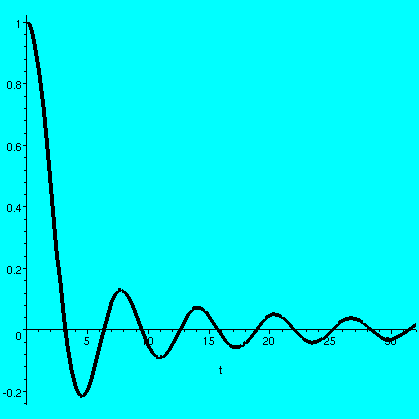
A graph of sin(t)/t on [0,32]
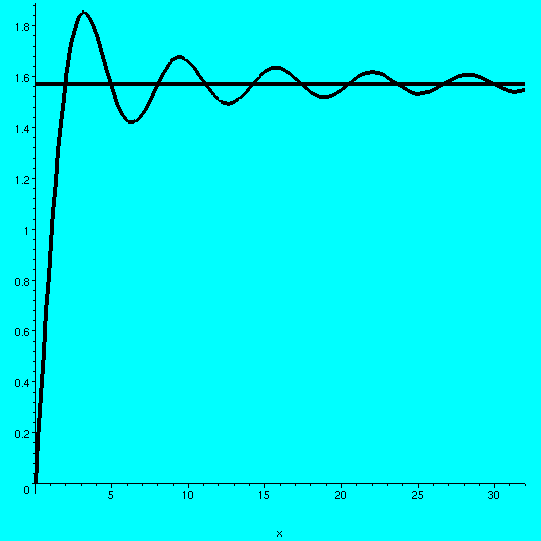
A graph of Si(t) and a horizontal
line at Pi/2 on [0,32]
|
Conclusions on the Laplace transform
Here are some of my feelings about the Laplace transform.
Good stuff
- Treats some "rough" functions (Dirac, Heaviside) which might
be useful in modeling real-world phenomena equally with a collection
of "ordinary" functions defined by formulas, including polynomials, some
trig functions, and some exponential functions.
- Unifies the initial conditions with the differential equations in
solving initial value problems.
- It is another tool to keep in mind when analyzing and solving (?)
ODE's.
Bad stuff
- If the function doesn't appear on a Laplace function table, and if
you can't deduce it using, say, the shift theorems and other results, and if a tool like
Maple can't either, then you might find difficulty in taking
the inverse Laplace transform ("Bromwich's integral" is an improper
complex line integral).
Laplace transforms do arise in other circumstances, such as
probability, when one considers the probability distribution function
of a sum of continuous random variables, and when the Central Limit
Theorem is analyzed. So what we've done is not the only use.
Award certificates were distributed
to students showing meritorious behavior (they came to class) during
the Laplace transform part of the course.
We will next study linear algebra. Please look at the newly expanded
and complete syllabus for the course.
The QotD was: what is the Laplace transform of the function
which is t from 0 to 2, and is then t2? This is
t+H(t-2)(t-t). We rewrite t2-t in terms of
t-2:
t2-t=([t-2]+2)2-t=(t-2)2+4(t-2)+4-t=(t-2)2+4(t-2)+2+(2-t)=(t-2)2+4(t-2)-(t-2)+2=(t-2)2+3(t-2)+2.
So the Laplace transform of H(t-2)(t-t)
will be e-2s(2/s3+3/s2+2/s) and then
we must add 1/s2, the Laplace transform of t.
So the answer is
e-2s(2/s3+3/s2+2/s)+1/s2.
|
Thursday,
February 5 |
1. Salt water
I stated and solved a nice problem from an
essay by Kurt Bryan of the Rose-Hulman Institute of Technology:
| A salt tank contains 100 liters of pure
water at time t=0 when water begins flowing into the tank at 2 liters
per second. The incoming liquid contains 1/2 kg of salt per liter. The
well stirred liquid lows out of the tank at 2 liters per second. Model
the situation with a first order ODE and find the amount of the salt
in the tank at any time.
|
I remarked that I expected students had modeled and solved such
problems a number of times in various courses, and certainly in Math
244. I did change my initial choice of name for the amount of salt, s,
since continuing with that led to expressions like sS(s) on the
Laplace transform side, and I make enough errors already!
Let y(t) be the kgs of salt in the tank at time t in seconds. We are
given information about how y is changing. Indeed, y(t) is increasing
by (1/2)2 kg/sec (mixture coming in) and decreasing by (2/100)y(t),
the part of the salt in the tank at time t leaving each second. So we
have:
y'(t)=1-(1/50)y(t) and y(0)=0 since there is initially no salt in the
tank.
Mr. Marchitello described what the
solutions should look like: a curve starting at the origin, concave
down, increasing, and asymptotic to y=50. In the long term, we expect
about 50 kgs of salt in the tank.
This is easy to solve by a variety of methods, but in 421 we should
use Laplace transforms: so let's look at the Laplace transform of the
equation. We get sY(s)-y(0)=(1/s)-(1/50)Y(s). Use y(0)=0 and solve for
Y(s). The result is Y(s)=1/[s(s+(1/50))]. This splits by partial
fractions of some guesses to Y(s)=50[(1/s)-(1/(s+(1/50)))]. It is
easy to find the inverse Laplace transform and write
y(t)=50(1-e-(1/50)t) which is certainly the expected solution.
Now the problem becomes more interesting.
| Suppose that at time t=20 seconds 5 kgs
of salt is instantaneously dropped into the tank. Modify the ODE from
the previous part of the problem and solve it. Plot the solution to
make sure it is sensible. |
Now things are slightly more interesting. First I asked students what
would likely happen. They remarked that they expected a jump in y(t)
at time 20 of 5, but that then the solution would continue to go
asymptotically to 50 when t is large. How should the ODE be modified
to reflect the new chunk of salt? After some discussion, we decided it
should be
y'(t)=1-(1/50)y(t)+5delta(t-20) and y(0)=0.
The delta function at t=20 represents the "instantaneous"
change in y(t) at time 20, an immediate impulsive (?) increase in the
amount of salt present.
Several substantive comments were made by students about this
model. One, by Mr. Ivanov, was that
real salt would probably drop in a clump to the bottom of the
tank and would be dissolved at some real rate, not "instantaneously", by
the mixing fluid. I think he is correct, more or less. But all of this
modeling is more or less a first approximation (and an exercise in
using Laplace transforms!).
Mr. Wilson had a different question
after class. He asked why the delta function was appropriate in
the equation for dy/dt. Certainly the salt (as a function of time)
would have a Heaviside function added, but why does that turn into a
delta function in the derivative? I think his question is a
good one, which will be the first topic I'll try to discuss in the
next class. But, briefly, a Heaviside function is mostly flat, so,
mostly, its derivative should be 0. But it does have an instant (?!)
jump of one unit, and the change represented by that jump is modeled
by an appropriate delta function. That statement needs more
justification, which I will try to give.
Back to solving y'(t)=1-(1/50)y(t)+5delta(t-20) and y(0)=0.
Take the Laplace transform as before, and use the initial condition
as before. The result is now
sY(s)-y(0)=(1/s)-(1/50)Y(s)+5e-20s from which we get
Y(s)=50[(1/s)-(1/(s+(1/50)))]+5[e-20s/(s+(1/50))] which has
inverse Laplace transform
y(t)=50(1-e-(1/50)t)-5H(t-20)e-(1/50)(t-20). Of
course I wanted to check my answer, so I used Maple. Here is
the command line and here is Maple's response:
invlaplace(1/(s*(s+(1/50))) +5*exp(-20*s)/(s+(1/50)),s,t);
100*exp(-1/100*t)*sinh(1/100*t)+ 5*Heaviside(t-20)*exp(-1/50*t+2/5)
Well, Maple multiplied 1/50 by 20 to get
2/5. Slightly more interesting is the sinh (hyperbolic sine,
pronounced "cinch") part. Apparently users of Maple are
expected to know that sinh(w)=(ew-e-w)/2. If you
know that, then you can see that Maple's answer is
equal to ours. You probably should also know about hyperbolic cosine,
cosh, (pronounced "cosh") which is defined by
cosh(w)=(ew+e-w)/2. Anyway, our answer does
agree with Maple's. I also asked Maple to draw the solution,
and the graph is to the right, with a dotted line at y=50. The solution is plotted on the interval
[0,150]. A jump is visible at 20, and the asymptotic behavior is also
displayed. In class I thought that the jump would have put the salt
above the equilibrium amount, and there would be decrease
afterwards. This does happen if you dump in 20 kgs of salt in at t=100, say,
and then plot the solution from 0 to 250. The second picture shows
that solution.
| 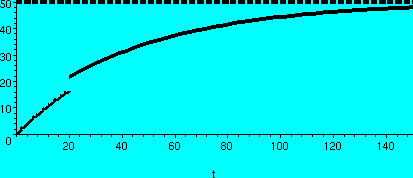
5 kgs in at 20 secs
and t in [0,150].
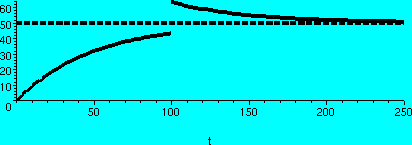
20 kgs in at 100 secs
and t in [0,250].
|
2. Resonances revisited
I went back to the problem I discussed during the last lecture, which
was "kicking" an ideal spring periodically. So the model is y''+y=a
sum of delta functions. If the delta functions are
spaced 2Pi apart, then one can explicitly solve and see by evaluating
at specific points that the function is unbounded (there is
"resonance") and that some aspect of the model (or of reality!)
fails.
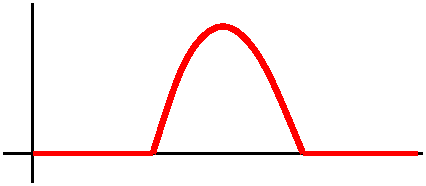 I then asked students to think about the physical motion of such a
spring which is kicked every Pi, so that y''+y=the sum of
delta(t-j Pi) as j goes from 1 to infinity. I asked people
to guess what the physical motion of the spring would be. After some
silence, Mr. Morgan waved a finger to
illustrate the beginning of a graph which looked like what's
displayed. I said that was correct, and solution of the model shows
exactly such behavior. There didn't seem to be much agreement, so I
remarked that I would make this a homework problem.
I then asked students to think about the physical motion of such a
spring which is kicked every Pi, so that y''+y=the sum of
delta(t-j Pi) as j goes from 1 to infinity. I asked people
to guess what the physical motion of the spring would be. After some
silence, Mr. Morgan waved a finger to
illustrate the beginning of a graph which looked like what's
displayed. I said that was correct, and solution of the model shows
exactly such behavior. There didn't seem to be much agreement, so I
remarked that I would make this a homework problem.
Now what happens when the kicking occurs at positive integer
intervals, so that we have
y''+y=delta(t-1)+delta(t-2)+delta(t-3)+delta(t-4)+...
Initially the spring is unmoving: y(0)=0 and y'(0)=0. The Laplace
transform then gives
(s2+1)Y(s)=e-s+e-2s+e-3s+e-4s+...
The right-hand side is a geometric series (Google has about
670,000 pages with geometric series on them, and the first
ideas of geometric series are usually taught in U.S. high schools and
sometimes junior high schools). The first term is
e-s (called "a") and the constant ratio between successive
terms is also e-s (called "r"). The sum of
a+ar+ar2+ar3+... is a/(1-r), so the sum of the
right-hand side of the Laplace transformed equation is
e-s/(1-e-s). Therefore
Y(s)=(1/(s2+1))·(e-s/(1-e-s)).
My guess is there is no huge reinforcement of amplitudes, so the
inverse Laplace transform of
(1/(s2+1))·(e-s/(1-e-s))
should be bounded. I have a picture of this inverse
transform in the interval [0,30]. The picture is weird and
wiggly. It does not convince me that that the function will be bounded
from t=0 to, say, t=10,000. This sort of question might well come up
in practice. Using a computer to plot something so delicate out to
10,000 is difficult. I tried to find an explicit inverse Laplace
transform in our tables, and then I used Maple. I could not
find any help. What could an engineer do now?
... not an official part of the course ... not an official part of the
course ... not an official part of the course ...
It turns out that there is a direct link from the function Y(s) to
y(t), an inverse Laplace transform formula. It is called the Bromwich
integral. This says that if Y(s) is the Laplace transform of a
function, and if all of the complex singularities of Y are to the
right of the vertical line x=c in the complex plane, then y(t)= c-i inftyc+i inftyestY(s) ds.
Here one nominally evaluates this integral by parameterizing s by
c+iw, so ds is i dw, etc. I wrote "nominally" because it turns
out that there are lots and lots of tricks involved in computing these
integrals (complex variables! [Math 403 is an undergrad course in
complex variables.]). I can use these tricks to get a bound
on the y(t) function that comes from the integer "kicks" and therefore
the motion never gets really big. Although this is not a part of the
course, and is not, unfortunately, even stated in the text,
YOU SHOULD KNOW that such a connection
exists and have it as, perhaps, a last resort when analyzing Laplace
transforms. c-i inftyc+i inftyestY(s) ds.
Here one nominally evaluates this integral by parameterizing s by
c+iw, so ds is i dw, etc. I wrote "nominally" because it turns
out that there are lots and lots of tricks involved in computing these
integrals (complex variables! [Math 403 is an undergrad course in
complex variables.]). I can use these tricks to get a bound
on the y(t) function that comes from the integer "kicks" and therefore
the motion never gets really big. Although this is not a part of the
course, and is not, unfortunately, even stated in the text,
YOU SHOULD KNOW that such a connection
exists and have it as, perhaps, a last resort when analyzing Laplace
transforms.
3. Some systems
The next section in the text uses the Laplace transform to solve some
simple linear systems. I was uninspired, and did problem #2 in section
3.6. I hope I solved it correctly. Here it is:
2x'-3y+y'=0
x'+y'=t
with initial conditions x(0)=0 and y(0)=0. I asked people if they had
done such problems in 244, and got mumbled replies that seemed to
include, "Yeah, maybe, with linear algebra or something." The
enthusiasm was shrinking like exponential decay. We Laplace
transformed the equations, taking advantage of the initial
conditions.
2sX(s)-2x(0)-3Y(s)+sY(s)+y(0)=0
sX(s)-x(0)+sY(s)-y(0)=1/s2
so that
2sX(s)-3Y(s)+sY(s)=0 and
sX(s)+sY(s)=1/s2
If we multiply the second equation by 2 and subtract it from the
first, we get -(s+3)Y(s)=-2/s2 so that
Y(s)=2/[s2(s+3)]=A/s+B/s2+C/(s+3) (partial
fractions) and so 2=As(s+3)+B(s+3)+Cs2. The magic number
s=0 tells me that B=2/3 and s=-3 tells me that C=2/9. I could then
work on getting A, but we know already because of our huge
Laplace transform table that y(t) must be A+Bt+Ce-3t so that
y(0) will be A+C and since y(0)=0 and C=2/9 then A must be -2/9. This
cute idea came from Mr. Wilson. Therefore
y(t)=(-2/9)+(2/3)t+(2/9)e-3t. Maple packages this
answer as -2/3*t-4/9*exp(-3/2*t)*sinh(3/2*t) which does work
out to be the same as ours.
What about X(s)? Since sX(s)+sY(s)=1/s2 we know that
X(s)+Y(s)=1/s3 and
X(s)=1/s3-Y(s)=1/s3+known stuff. Therefore
x(t)=(t2/2)-[(-2/9)+(2/3)t+(2/9)e3t].
I checked with Maple and these formulas do satisfy the
original equations.
I began to run out of energy, especially since I had left one page of
my notes (two sides!) back in my office. I don't have this stuff
memorized, I don't know it well enough, and ... well, those students
who did not attend were missing a mediocre experience at best.
Even the QotD (which I had prepared!) was screwed up. I tried
in invent a system "on the fly" which people could solve by
Laplace transforms. I should have settled for asking that people
translate the system via Laplace transforms and then solve for one
Laplace variable, such as Y(s). The system I wrote was:
x'+x+y'=delta(t-1)
4x'+2y+y'=1
with the initial conditions x(0)=0 and y(0)=0 to make it easy, of
course.
The Laplace transform is:
sX(s)+X(s)+sY(s)=e-s
4sX(s)+2Y(s)+sY(s)=1/s
after using the initial conditions. This becomes two linear equations
in X(s) and Y(s):
(s+1)X(s)+sY(s)=e-s
4sX(s)+(s+2)Y(s)=1/s
Multiply the first equation by 4s and the second equation by
(s+1):
4s(s+1)X(s)+4s2Y(s)=4s e-s
(s+1)4sX(s)+(s+1)(s+2)Y(s)=(s+1)/s
Subtract the second equation from the first equation:
[4s2-(s+1)(s+2)]Y(s)=4s e-s-(s+1)/s
and divide:
Y(s)=[4s e-s-(s+1)/s]/[4s2-(s+1)(s+2)]
This is fairly horrible and I am
embarrassed. It is much too hard for me to solve "by
hand". Maple does it, of course, in about a tenth of a second.
That's a very large chunk of time -- Maple takes
less than a thousandth of a second to find the exact sum of the
fifth powers of the first thousand integers! This was a very poor
QotD.
 The homework is: finish
reading Chapter 3. Please hand in 3.5: 3, 15, 19 and 3.6: 9. Please
solve the equation y''+y=the sum of
delta(t-j Pi) as j goes from 1 to infinity.
subject to the initial conditions y(0)=0 and y'(0)=0 and graph
your solution! You may verify that Mr. Morgan's guess is essentially
correct, but supply more of a graph and more coordinates on the graph!
The homework is: finish
reading Chapter 3. Please hand in 3.5: 3, 15, 19 and 3.6: 9. Please
solve the equation y''+y=the sum of
delta(t-j Pi) as j goes from 1 to infinity.
subject to the initial conditions y(0)=0 and y'(0)=0 and graph
your solution! You may verify that Mr. Morgan's guess is essentially
correct, but supply more of a graph and more coordinates on the graph!
Hint for 3.5 #15
|
Early Warning
We should have a test fairly soon: about ten days or two weeks. Please let me know
what exams you have in your major courses, and I will try to avoid
close conflicts as much as I can. Tuesday will be the last lecture on
Laplace stuff, and then we will move on to master Linear Algebra.
|
|
|
Tuesday,
February 3 |
More about history of the people mentioned in this part of the
course
Oliver Heaviside remarked: "Should I refuse a good dinner simply
because I do not understand the process of digestion?" (This refers to
the lack of rigorous mathematical foundation for much of his work.) Here is
another quote from Heaviside: "Mathematics is an experimental
science, and definitions do not come first, but later on." I
believe I agree with this statement. Heaviside was an engineer. One of
his accomplishments was creating an "operational calculus" for
solving differential equations. We have been studying his methods,and
will conclude today by introducing a "function" named for Dirac.
Dirac,
a Nobel prize-winning mathematical physicist, worked on
quantum mechanics and relativity. Here is an interesting quote from Dirac:
"I consider that I understand an equation when I can predict the properties of its solutions, without actually solving it."
A contemporary interview with Dirac may give
some idea of his personality.
As you will see, the Dirac function isn't a function (!) so
indeed there are difficulties.
Here is
a nice essay about the delta function and Laplace transforms.
And now (finally!) to the class
I began this lecture by finishing the remarks about convolution: how
approximate integration of the convolution integral in the problem I
analyzed last time makes real-world sense, and is computationally very
feasible. (Please see the discussion at the end of the previous
lecture.)
Here are some properties of convolution which can be useful in
computations.
| Convolution facts |
|---|
| Commutativity | f * g = g * f |
|---|
| Associativity | (f * g) * h = f * (g * h) |
|---|
Linearity in
each variable |
(f1+f2) * g = (f1 * g) +
(f2 * g)
f * (g1+g2) = (f * g1) +
(f * g2)
|
|---|
Then I did Problem #20 in section 3.4, which is: find f(t) if you know
that
f(t)=-1+t-2 0tf(t-tau)sin(tau) dtau. Of course we
recognize the integral as a convolution (this is a problem in a
textbook, darn it!). If we take the Laplace transform of both sides,
then the equation becomes
F(s)=-(1/s)+(1/s2)-2(F(s)/(s2+1)). The
convolution turns into multiplication. We then solve for F(s) and get
(after a bit of algebra)
F(s)=[-(1/s)+(1/s2)]·[(s2+1)/(s2+3)].
We can use partial fractions to split this up into
(A/s)+(B/s2)+(Cs+D)/(s2+3). As direct wrote in
the quote above, maybe we can try to predict the solution. In fact,
with the help of a table of transforms, I can read off that f(t) will
be A+Bt+C cos(sqrt(3)t)+(D/sqrt(3))sin(sqrt(3)t). I tried this by
hand, and then had Maple use invlaplace on
it. Maple reported that the solution was
-(2/3)cos(sqrt(3)t)+(2/9)sqrt(3)sin(sqrt(3)t)+(t/3)-(1/3). This has
the predicted form, so I was sort of happy. But I then went on, and
used Maple to check that this function actually satisfied
the integral equation I started with.; For a human being, this check
would have been a rather irritating computation, but for Maple
the confirmation was rapid and easy 0tf(t-tau)sin(tau) dtau. Of course we
recognize the integral as a convolution (this is a problem in a
textbook, darn it!). If we take the Laplace transform of both sides,
then the equation becomes
F(s)=-(1/s)+(1/s2)-2(F(s)/(s2+1)). The
convolution turns into multiplication. We then solve for F(s) and get
(after a bit of algebra)
F(s)=[-(1/s)+(1/s2)]·[(s2+1)/(s2+3)].
We can use partial fractions to split this up into
(A/s)+(B/s2)+(Cs+D)/(s2+3). As direct wrote in
the quote above, maybe we can try to predict the solution. In fact,
with the help of a table of transforms, I can read off that f(t) will
be A+Bt+C cos(sqrt(3)t)+(D/sqrt(3))sin(sqrt(3)t). I tried this by
hand, and then had Maple use invlaplace on
it. Maple reported that the solution was
-(2/3)cos(sqrt(3)t)+(2/9)sqrt(3)sin(sqrt(3)t)+(t/3)-(1/3). This has
the predicted form, so I was sort of happy. But I then went on, and
used Maple to check that this function actually satisfied
the integral equation I started with.; For a human being, this check
would have been a rather irritating computation, but for Maple
the confirmation was rapid and easy
An impulse and limits of impulses
We can think of an impulsive "kick" as mechanically sort of the limit
of a square wave. Let me show you how Heaviside might have presented
this. The total area under a wave is the amount of the impulse. So if
I want to somehow keep this constant but would like to shrink the time
in which the energy is transferred, then I need to make the amplitude
higher. So what I did was create a square wave which was 0 for x<0
and for x>epsilon. If I want the total area to still be 1, then
inside the interval [0,epsilon] the function should be 1/epsilon. The
graph then is a rectangular block whose area is
epsilon·1/epsilon=1. What's the Laplace transform of this function? We
can do a direct computation, as we already have several times with
such functions. Or, better in this course, we can express the function
with Heaviside functions and use our tables. Then the function is
(1/epsilon)H(t)-(1/epsilon)H(t-epsilon). The Laplace transform of this (using
results from the last lecture) is
(1/epsilon)(1/s)-(1/epsilon)e-epsilon s(1/s). It takes some effort
not to rewrite this, and why resist:
(1/s)[(1-e-epsilon s)/epsilon]. What happens to the impulse
as epsilon-->0? This is a limit, and I'll plug in epsilon=0. The result
is 0/0 (much better than 56/0, actually!). So I can try l'Hopital's
rule, and differentiate the top and bottom with respect to
epsilon. Although each step in all this is easy (almost trivial, maybe)
the opportunity for confusion is large, because there always seem to
be extra variables present. In this case, the result of d/depsilon top and
bottom is (1/s)[(--s e-epsilon s)/1]. Now if epsilon-->0,
the result is s/s or 1. The Laplace transform of this limiting impulse
is 1.
The picture below is an almost poetic (!) attempt to show you what's
happening. As the impulses get narrower and higher (but all with
area=0) the corresponding Laplace transforms are exponentials which
-->1.
| A sequence of impulses | Their Laplace transforms |
|---|
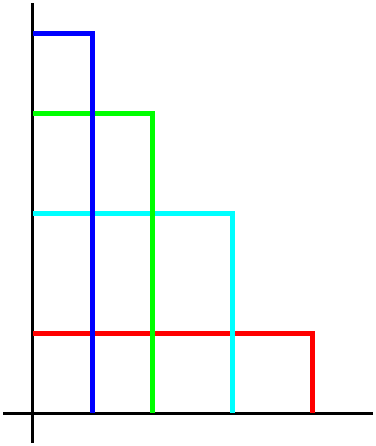 |
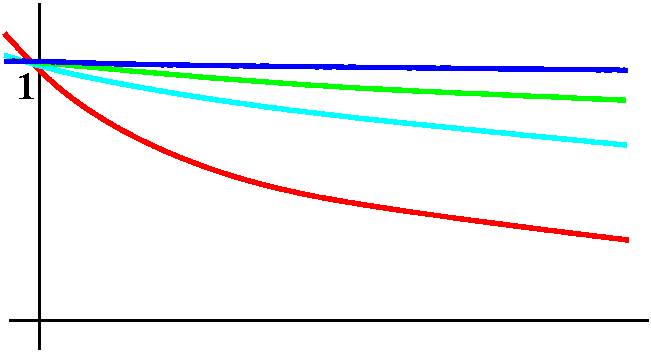
|
A comment
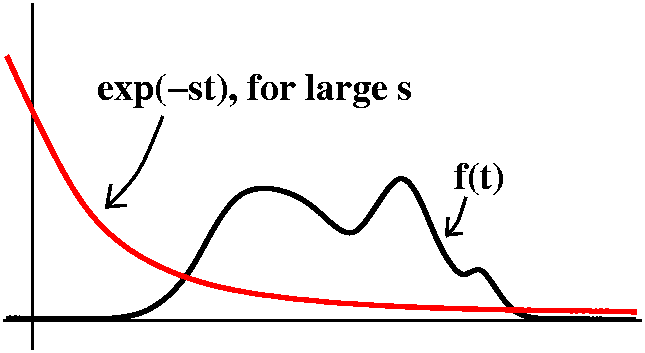 Something a bit startling has occurred. When I began discussing Laplace
transforms, I declared that if f(t) were some sort of blobby function,
then the Laplace transform would be gotten by integrating the product
of f(t) with e-st. And if you consider the picture, when s
gets really really really large, then the exponential dies down very
very very fast, and so the Laplace transform should -->0 as
s-->infty. But we seem now to have a Laplace transform (the limit of
the square waves) which is is 1, so something seems wrong. This is
more or less the position of academic mathematicians when Heaviside
was presenting his methods. In fact, almost half a century passed
before the ideas of Heaviside would become part of rigorous
mathematical thought. His feeling, and that of many engineers and
physicists, was that, my goodness, the methods work, so use them and
don't worry too much.
Something a bit startling has occurred. When I began discussing Laplace
transforms, I declared that if f(t) were some sort of blobby function,
then the Laplace transform would be gotten by integrating the product
of f(t) with e-st. And if you consider the picture, when s
gets really really really large, then the exponential dies down very
very very fast, and so the Laplace transform should -->0 as
s-->infty. But we seem now to have a Laplace transform (the limit of
the square waves) which is is 1, so something seems wrong. This is
more or less the position of academic mathematicians when Heaviside
was presenting his methods. In fact, almost half a century passed
before the ideas of Heaviside would become part of rigorous
mathematical thought. His feeling, and that of many engineers and
physicists, was that, my goodness, the methods work, so use them and
don't worry too much.
I then tried to analyze some more properties of this limiting square
wave. I said suppose we take a positive integer n and define
fn by making it n on the interval [0,1/n] and 0
elsewhere. This is a sequential version of the epsilon
impulse. Now I asked: what is limn-->infty  -3645fn(x) dx? This may look
formidable but it is easy, because the box is inside the interval
[-36,45] and the box's area is always 1, so the limit is 1. What about limn-->infty -3645fn(x) dx? This may look
formidable but it is easy, because the box is inside the interval
[-36,45] and the box's area is always 1, so the limit is 1. What about limn-->infty  2358fn dx? Here again the limit is
easy, because inside the interval [23,58] all the fn's have value
0. The limit is 0. 2358fn dx? Here again the limit is
easy, because inside the interval [23,58] all the fn's have value
0. The limit is 0.
Now let's try a more sophisticated limit. Suppose
g(x)=ex+7+6x2. What is limn-->infty
 -518fn(x)g(x) dx? Of course please
realize that -5 and 18 are mostly irrelevant. All that really matters
is that the x's where fn(x) is not 0 are inside [-5,18]. If you
think carefully about the picture, you can see that the integral is
narrowing down and weighting more and more the value g(0). If you want
some better "intuition", here: the integral from 0 to 1/n (that's
where fn is not 0) of g(x) is equal to g(some number between 0 and
1/n) multiplied by the length of the interval of integration, which is
1/n. So -518fn(x)g(x) dx? Of course please
realize that -5 and 18 are mostly irrelevant. All that really matters
is that the x's where fn(x) is not 0 are inside [-5,18]. If you
think carefully about the picture, you can see that the integral is
narrowing down and weighting more and more the value g(0). If you want
some better "intuition", here: the integral from 0 to 1/n (that's
where fn is not 0) of g(x) is equal to g(some number between 0 and
1/n) multiplied by the length of the interval of integration, which is
1/n. So  -518fn(x)g(x) dx = -518fn(x)g(x) dx =
 01/nfn(x)g(x) dx =
n 01/nfn(x)g(x) dx =
n 01/ng(x) dx. The last equality is
correct because the function fn is n inside the interval [0,1/n].
But 01/ng(x) dx. The last equality is
correct because the function fn is n inside the interval [0,1/n].
But  01/ng(x) dx =g(some number in
[0,1/n])·(1/n) by Mean Value Theorem for Integrals. The 1/n and
n cancel, so that 01/ng(x) dx =g(some number in
[0,1/n])·(1/n) by Mean Value Theorem for Integrals. The 1/n and
n cancel, so that
 01/nfn(x)g(x) dx = g(some number
between 0 and 1/n). Since our g(x)=ex+7+6x2 is
continuous, g's values near 0 approach g(0) which is
e0+7=8. Therefore
limn-->infty 01/nfn(x)g(x) dx = g(some number
between 0 and 1/n). Since our g(x)=ex+7+6x2 is
continuous, g's values near 0 approach g(0) which is
e0+7=8. Therefore
limn-->infty 01/nfn(x)g(x) dx = g(0) = 8. 01/nfn(x)g(x) dx = g(0) = 8.
What Mr. Heaviside then did, which upset the academics, was define the
delta function at 0, delta(t), (now usually called the
Dirac delta function) by limn-->inftyfn(x). This is more a
"function" than a function. Why is this? The value of delta(t)
for t not equal to 0 is surely 0. But the integral of t from -infty
to +infty is "surely" 1 (well, I want it to have integral 1). If
delta(t) were an ordinary function, it would need a value at 0,
and maybe the value at 0 would have to be infinity? (And I don't understand infinity very well!)
| Behavior of the delta "function" |
|---|
- If t is not 0, then delta(t)=0
- The Laplace transform of delta(t) is the constant function
1.
- If g is continuous, then
 -infty+inftydelta(t)·g(t) dt=g(0). -infty+inftydelta(t)·g(t) dt=g(0).
|
We can translate the delta function, just as we translated the
Heaviside function. What does delta(t-5) do? The center of
interest is then where t-5 is 0, or where t=5. That means, for
example, that  -inftyinftydelta(t-5)·g(t) dt
must be g(5) if g is continuous at 5. Etc. -inftyinftydelta(t-5)·g(t) dt
must be g(5) if g is continuous at 5. Etc.
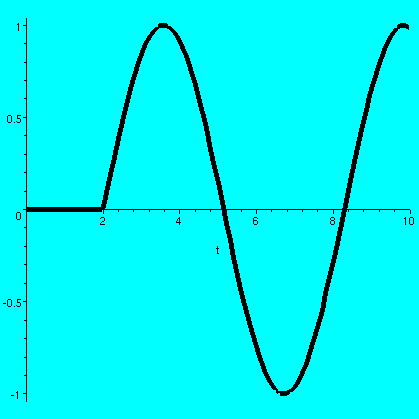 So it is time to solve a differential equation. Let's try something
simple (of course!): y''+y=delta(t-2) with the initial
condition y(0)=0 and y'(0)=0. So this is a vibrating spring with no
damping initially unmoving and in equilibrium, which we kick at
t=2. Let's take the Laplace transform. The left-hand side is easy
because all the complicated stuff drops out due to the initial
conditions. We get (s2+1)Y(s). The right-hand side is
e-2s1 (the "1" is the Laplace transform of the delta
function and the e-2s is because we have shifted by 2 in
the time variable). Then Y(s)=(e-2s)/(s2+1). We
transform back, noting that the exponential now makes "everything"
start at 2: y(t)=H(t-2)sin(t-2). Here is the entire dialog of a
Maple session to compute the solution, and then produce the
graph shown.
So it is time to solve a differential equation. Let's try something
simple (of course!): y''+y=delta(t-2) with the initial
condition y(0)=0 and y'(0)=0. So this is a vibrating spring with no
damping initially unmoving and in equilibrium, which we kick at
t=2. Let's take the Laplace transform. The left-hand side is easy
because all the complicated stuff drops out due to the initial
conditions. We get (s2+1)Y(s). The right-hand side is
e-2s1 (the "1" is the Laplace transform of the delta
function and the e-2s is because we have shifted by 2 in
the time variable). Then Y(s)=(e-2s)/(s2+1). We
transform back, noting that the exponential now makes "everything"
start at 2: y(t)=H(t-2)sin(t-2). Here is the entire dialog of a
Maple session to compute the solution, and then produce the
graph shown. with(inttrans):
laplace(Dirac(t-2),t,s);
exp(-2 s)
invlaplace(exp(-2*s)/(s^2+1),s,t);
Heaviside(t - 2) sin(t - 2)
plot(%,t=0..10,thickness=5,color=black);
That is nice and easy, I think. I wanted to present a more
interesting physical situation to you, or, rather, a model of a more
interesting physical situation.
BOOM! BOOM!! BOOM!!!
Chris Stucchio, a mathematics graduate
student here, suggested the following. There was once a proposal to
propel spaceships by exploding atom bombs in back of them and using
the push from the explosions to move the spaceships. We are
not making this up! It was called Project
Orion. Since from a real-time point of view, an atom bomb
explosion is darn near an idealized delta impulse, I guess we
could have analyzed the resulting motion. Instead, I was more modest.
Resonance
I think that Ms. Kohut suggested we try
to "kick" the vibrating spring periodically. So I tried to analyze
this equation:
y''+y=delta(t-Pi)+delta(t-3Pi)+delta(t-5Pi)+delta(t-7Pi)+delta(t-9Pi)+...
with initial conditions y(0)=0 and y'(0)=0.
Now Laplace transform everything:
(s2+1)Y(s)=e-(Pi)s+e-(3Pi)s+e-(5Pi)s+e(-7Pi)s+...
and divide by s2+1 and transform back. The solution seems
to be
y(t)=H(t-Pi)sin(t-Pi)+H(t-3Pi)sin(t-3Pi)+H(t-5Pi)sin(t-5Pi)+H(t-7Pi)sin(t-7Pi)+...
and I've shown a graph of this on the interval from t=0 to t=30. It
certainly looks like the model must break down somewhere (Hooke's law
not valid, spring breaks, etc.). Look at what happens at (1.5)Pi, (3.5)Pi,
(5.5)Pi, etc. (y(t)'s values at those t's are 1, 2, 3, etc.).
Be a bit careful, please. This is not a
picture of "smooth motion". There's kinky behavior (first derivative
doesn't exist) at each odd multiple of Pi, corresponding to another
delta function kick. Here is a closeup of the graph around 3Pi,
so you can see the corner. I think the previous "bigger" view conceals
this finer "structure".
Challenge to the Mechanical Engineers
Can you predict, without computation, what would happen if we kicked
the spring every Pi instead of every 2Pi? I couldn't and the answer
after I computed it was slightly surprising to me. Can you?
Non-resonance?
Remember that Pi is not rational: that is, it is not a quotient of
integers. What if we "kick" the spring every integer? If you think
things through, the kicks should not reinforce each other, and instead
they should somehow distribute "around" the sine wave. Well, here is
what I did. I tried to solve
y''+y=delta(t-1)+delta(t-2)+delta(t-3)+... with
y(0)=0 and y'(0)=0. Then Laplace transform tells me that
Y(s)=[e-s+e-2s+e-3s+...]/(s2+1)
and the inverse Laplace transform is
H(t-1)sin(t-1)+H(t-2)sin(t-2)+H(t-3)sin(t-3)+H(t-4)sin(t-4)+...
A picture is shown of the first thirty terms graphed on the interval
[0,30]. The curve certainly seems very bounded, as if there is no
reinforcement from resonance. I can't prove this. If we work on the
Laplace transform some more, starting with
Y(s)=[e-s+e-2s+e-3s+...]/(s2+1)
the top is a geometric series with first term e-s and whose
ratio is also e-s. So actually
Y(s)=[1/(s2+1)]·[e-s/(1-e-s)].
This is a product, so y(t) would be a convolution of sine (whose
Laplace transform is [1/(s2+1)]) and a function whose
Laplace transform is e-s/(1-e-s)]. I don't know
such a function, and, it seems, neither does Maple. So I
can't go any further right now. Is it "clear" or "obvious" that the
spring's motion is bounded to you? It isn't to me.
|
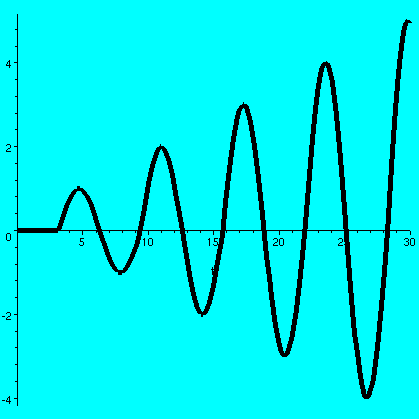
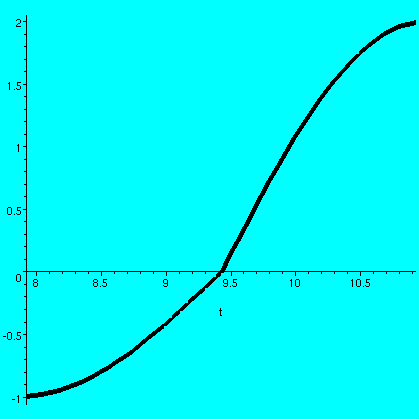
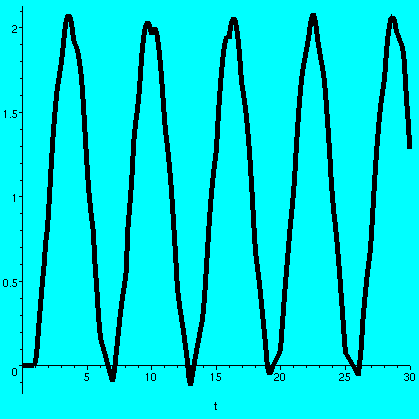
|
The QotD was: compute
 0100[etcos(t)][5delta(t-Pi)+30delta(t-3Pi)] dt.
Here I hoped that my explanation of the Dirac delta function
was enough. I expected the answer would be (using linearity of the
integral) 5·(the value of [etcos(t)] at
t=Pi)+30·(the value of [etcos(t)] at t=3Pi). This is
-5ePi-30e3Pi. Most people seemed to get this
correct (please note that cos(Pi) and cos(3Pi) are both -1,
though!). 0100[etcos(t)][5delta(t-Pi)+30delta(t-3Pi)] dt.
Here I hoped that my explanation of the Dirac delta function
was enough. I expected the answer would be (using linearity of the
integral) 5·(the value of [etcos(t)] at
t=Pi)+30·(the value of [etcos(t)] at t=3Pi). This is
-5ePi-30e3Pi. Most people seemed to get this
correct (please note that cos(Pi) and cos(3Pi) are both -1,
though!).
Continue reading the book.
|
Thursday,
January 29 |
Well, the first 10 or 15 minutes of class lasted almost an hour. I
hope that the experience was worthwhile.
Motivated by the fact that most students had gotten the previous QotD
wrong, which is really not my aim, I decided to begin by asking
pairs of students to "compute" Laplace transforms and inverse Laplace
transforms. The computations would use information from the book and
some examples I copied from Maple.
| Information from the text (we also computed most of
these in class) |
|---|
| Function | Laplace transform |
|---|
| tn
| n!/sn+1
|
| eat
| 1/(s-a)
|
| sin(at)
| a/(s2+a2)
|
| cos(at)
| s/(s2+a2)
|
|
| Examples from Maple (using
laplace and invlaplace in the package inttrans) |
|---|
| Function | Laplace transform |
|---|
| t
| 1/s2
|
| tet
| 1/(s-1)2
|
| H(t-1)
| e-s/s
|
| H(t-2)[(t-2)et-2]
| e-2s/(s-1)2
|
|
It was my hope that the Maple examples would help students
as they worked on the questions I gave them. Also students should be
studying and reading the text. The text has formal statements of the
needed theorems, and also has more examples.
#1
Mr. Cohen
and
Mr. Ivanov
kindly tried to find the Laplace transform of sin(t)H(t-5). They wrote
sin(t)=sin(t-5+5)=sin(t-5)cos(5)+cos(t-5)sin(5). Then they used
linearity and the shifting theorem, which demands as input a function
of the form H(t-a)f(t-a) and then has as output
e-asF(s). The result in this case is
e-5s(cos(5)/(s2+1)+sin(5)s/(s2+1).
#2
Here I gave the Laplace transform, e-3s/(s2+4),
and asked students (whose names I don't remember!) to find the
function it "came from" (Lerch's Theorem, the inverse Laplace
transform). The e-3s in Y(s) indicates that y(t) will
"begin" with H(t-3). The other part, looking in the first table above,
gives something sort of about sin(2t). This isn't quite correct,
because we need to fix the y(t) with a 1/2 to compensate for the
missing "a" in the top of the Laplace transform of sin(at). But we must
also shift the function by 3. Therefore the desired y(s) is
H(t-3)sin(2(t-3)).
#3
Unknown students were confronted with Y(s)=s/[(s-3)(s-1)].
Yes, more
complete tables would permit us to look up the answer, but can we
get it from the information supplied? Yes, because we use partial
fractions, and want to write s/[(s-3)(s-1)] as A/(s-3)+B/(s-1). This
leads to A(s-1)+B(s-3)=s, so (s=3) A=3/2 and (s=1) B=-1/2, so that
Y(s)=(3/2)/(s-3)+(-1/2)/(s-1) so (linearity) y(t) must be (2/3)e3t+(-1/2)et.
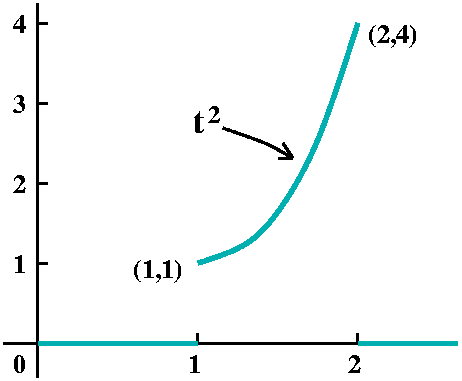 #4
#4
Here I gave graphical data. (The picture shown has differing units on
the horizontal and vertical axes.) The function y(t) was 0 before t=1 and
after t=2, and was t2 between 1 and 2. As I mentioned in
class, we could always compute the darn Laplace transform directly
from the definition. But I am supposed to show you how to use the
rather clever techniques developed (sometimes called the
operational calculus). So in terms of these techniques, we turn
t2
on at t=1, and then turn it off at t=2. To turn it on, write
H(t-1)t2.
Then we need to turn it off. This is
H(t-2)(-t2).
We would like to find the Laplace transform of
H(t-1)t2-H(t-2)(t2).
But the shifting theorem demands that the function multiplied by
H(t-1) be written in terms of t-1. Therefore write
t2=(t-1+1)2=(t-1)2+2(t-1)+1.
The Laplace transform of H(t-1)[(t-1)2+2(t-1)+1] is
e-s[2/s3+2/s2+1/s].
What about the other piece, -H(t-2)(t2)? Here we must write
t2 as a function of t-2:
t2=(t-2+2)2=(t-2)2+4(t-2)+4.
Therefore the Laplace transform of -H(t-2)(t2)
is the same as the Laplace transform of
-H(t-2)[(t-2)2+4(t-2)+4], and by shifting, this is
-e-2s[2/s3+4/s2+4/s].
Putting it all together, the result is
e-s[2/s3+2/s2+1/s]-e-2s[2/s3+4/s2+4/s].
I believe that the students who worked on this were
Ms. Sirak
and
Mr. Wilson
and I thank them.
#5
 Again, graphical input: the function was composed of three pieces of
straight lines. It was 0 until 5, then a line segment from (5,0) to
(6,1), and then a horizontal "ray" at height 1. We can write this
function as H(t-5)(line from (5,0) to (6,1))+H(t-6)(1-[line from (5,0)
to (6,1)]). The line connecting (5,0) to (6,1) has slope 1 and goes
through (5,0), so that its formula must be t-5. The function whose
Laplace transform we want is therefore
H(t-5)(t-5)+H(t-6)(1-[t-5])=H(t-5)(t-5)+H(t-6)(-t+6). Since (-t+6) is
-(t-6) we can apply the shifting theorem "immediately"(well,
almost). The desired Laplace transform is
e-5s(1/s2)-e-6s(1/s2).
Again, graphical input: the function was composed of three pieces of
straight lines. It was 0 until 5, then a line segment from (5,0) to
(6,1), and then a horizontal "ray" at height 1. We can write this
function as H(t-5)(line from (5,0) to (6,1))+H(t-6)(1-[line from (5,0)
to (6,1)]). The line connecting (5,0) to (6,1) has slope 1 and goes
through (5,0), so that its formula must be t-5. The function whose
Laplace transform we want is therefore
H(t-5)(t-5)+H(t-6)(1-[t-5])=H(t-5)(t-5)+H(t-6)(-t+6). Since (-t+6) is
-(t-6) we can apply the shifting theorem "immediately"(well,
almost). The desired Laplace transform is
e-5s(1/s2)-e-6s(1/s2).
#6
The last problem was a monster, and
Mr. Brynildsen
and
Mr. Elnaggar
kindly attempted it. It was an inverse Laplace
transform. I gave them Y(s)=e-3s/[(s-8)2+4]. I
wanted people to see that y(t) would have to"begin" at 3, so it would
have H(t-3) (because of the e-3s factor). The other part
looks very much like sine.
Let's try to get the inverse Laplace transform of
1/[(s-8)2+4]. The translation by 8 is gotten by multiplying
by e8t. The other part, the inverse Laplace transform of
1/[s2+4], must be (1/2)sin(2t). So the inverse Laplace
transform of [(s-8)2+4] is e8t(1/2)sin(2t).
But [(s-8)2+4] is multiplied by e-3s. That means
we prefix the inverse transform by H(t-3) and put t-3 in for t in the
other part of the inverse Laplace transform. Therefore the answer is
H(t-3)[e8(t-3)(1/2)sin(2(t-3))].
Well, I thought this would take 10 or 20 minutes, but we spent about
an hour on it. I hope that the effort was useful. Certainly I made as
many mistakes as all of the students together did, and I apologize for
that.
| The Shifting Theorems
|
|---|
| Function | Laplace transform |
|---|
| eatf(t)
| F(s-a)
|
| H(t-a)f(t-a)
| e-asF(s)
|
|
(The first result is the book's Theorem 3.7 and the second result is
the book's Theorem 3.8, both from section 3.3.) |
Today's topic: convolution and Laplace transform
Here's the definition. Suppose we have f(t) and g(t). Then the
convolution of f with g, written as f*g
(that's a star or asterisk between f and g), is defined by the formula
 0tf(t-tau)g(tau) dtau.
I'm using tau for the Greek letter used in the text in this
definition. 0tf(t-tau)g(tau) dtau.
I'm using tau for the Greek letter used in the text in this
definition.
The first time I "see" a mathematical object, I immediately try to
look at examples. Pure definitions rarely make sense to me.
Simple examples are almost always the best. So let's try
f(t)=t2 and g(t)=t3. Then f*g(t)=
 0t(t-tau)2(tau)3 dtau.
Expand so the integrand becomes
t2tau3-2ttau4+tau5.
Now antidifferentiate with respect to tau and substitute tau=t and
subtract off the value when tau=0 (the contribution from the lower
bound is 0 because we are dealing with monomials, but Warning! see what
happens in the QotD computation below. The result of the
antidifferentiation is
t2(1/4)tau4-2t(1/5)tau5+(1/6)tau6
and therefore the whole convolution is
(1/4)t6-(2/5)t6+(1/6)t6 which can be
"simplified" to
[(1/4)-(2/5)+(1/6]t6=[(15-24+10)t7=(1/60)t6. 0t(t-tau)2(tau)3 dtau.
Expand so the integrand becomes
t2tau3-2ttau4+tau5.
Now antidifferentiate with respect to tau and substitute tau=t and
subtract off the value when tau=0 (the contribution from the lower
bound is 0 because we are dealing with monomials, but Warning! see what
happens in the QotD computation below. The result of the
antidifferentiation is
t2(1/4)tau4-2t(1/5)tau5+(1/6)tau6
and therefore the whole convolution is
(1/4)t6-(2/5)t6+(1/6)t6 which can be
"simplified" to
[(1/4)-(2/5)+(1/6]t6=[(15-24+10)t7=(1/60)t6.
This doesn't seem very helpful. Historically I believe that
convolutions arose as a way to "package" solutions of differential
equations, as I will try to show later. But what you could notice
right now is the following:
f(t)=t2 has Laplace transform 2/s3.
g(t)=t3 has Laplace transform 6/s4.
(f*g)(t)=(1/60)t6 has Laplace transform
(1/60)(6!/s7).
Extensive computation (!) led us to 6!=720, and 720/60 is 12. If we
match up the powers and the coefficients we see that
2/s3·6/s4=(12/s7).
In this example the Laplace transform of f*g is the product of
the Laplace transform of f and the Laplace transform of g.
Here's an example I wanted to do in class. I want to compute
explicitly f*g where f(t)=et and g(t)=cos(t). Then
f*g(t)=
 0tet-taucos(tau) dtau.
Since et-tau=ete-tau, we can take
et out of the dtau integral. We need to find an
antiderivative of e-taucos(tau) dtau.
We could integrate
by parts twice, or use a trick we have already used once: cos(tau) is
the real part of eitau=cos(tau)+i sin(tau) so take the
real part of the antiderivative of
e-taueitau dtau=e(-1+i)tau dtau.
The antiderivative is [1/(-1+i)]e(-1+i)tau. Notice that
both of
the endpoints of the convolution integral contribute here, because
exponentials are 1 when their arguments are 0! Therefore we get
[1/(-1+i)][e(-1+i)t-1] and since (1/(-1+i)]=(-1-i)/2 and
e(-1+i)t is e-t(cos(t)+i sin(t)), we have
(1/2)(-1-i)(e-t(cos(t)+i sin(t)-1). The real part is
(1/2)(-e-tcos(t)+e-tsin(t)-1). 0tet-taucos(tau) dtau.
Since et-tau=ete-tau, we can take
et out of the dtau integral. We need to find an
antiderivative of e-taucos(tau) dtau.
We could integrate
by parts twice, or use a trick we have already used once: cos(tau) is
the real part of eitau=cos(tau)+i sin(tau) so take the
real part of the antiderivative of
e-taueitau dtau=e(-1+i)tau dtau.
The antiderivative is [1/(-1+i)]e(-1+i)tau. Notice that
both of
the endpoints of the convolution integral contribute here, because
exponentials are 1 when their arguments are 0! Therefore we get
[1/(-1+i)][e(-1+i)t-1] and since (1/(-1+i)]=(-1-i)/2 and
e(-1+i)t is e-t(cos(t)+i sin(t)), we have
(1/2)(-1-i)(e-t(cos(t)+i sin(t)-1). The real part is
(1/2)(-e-tcos(t)+e-tsin(t)-1).
To get the convolution we still must multiply by the et
factor we pulled out of the integral at the beginning. The convolution
is therefore
(1/2)(-e0cos(t)+e0sin(t)-et) which is
(1/2)(-cos(t)+sint(t)-et).
We can now look up the Laplace transform:
(1/2)(-s/(s2+1)+1/(s2+1)-1/(s-1)).
The Laplace transform of et is 1/(s-1) and the Laplace
transform of cos(t) is s/(s2+1). And (sigh, the details are
too irritating to write) the product of these two functions is the
transform of the convolution (again, partial fractions).
The following statement is true in general (see section 3.4):
The Laplace transform of the convolution is the product of the
Laplace transforms.
Here is a simple ODE with an initial condition: y'+3y=f(t) with
y(0)=5. I first solved the "associated homogeneous equation", which
wasn't too hard (a first-order constant coefficient ODE, after all):
the solution is 5e-3t. How does the input f(t) perturb or
affect this simple
solution? Well, let's take the Laplace transform of the whole
equation. Here is what results: sY(s)-y(0)+3Y(s)=F(s). Put in the
initial condition and solve for Y(s): Y(s)=F(s)/(s+3)+5/(s+3). Now
take (try to take?) the inverse Laplace transform. The 5/(s+3) term
leads to 5e-3t. The other term must be the result of f's
effect. Understand it this way: F(s)/(s+3) is the product of F(s) and
1/(s+3) so that its inverse Laplace transform is the convolution of
f(t) and e-3t. Write this out:
 0tf(t-tau)e-3(tau) dtau. 0tf(t-tau)e-3(tau) dtau.
This is more profound and useful than might appear. The
solution of y'+3y=f(t) with y(0)=5 is:
5e3t +  0tf(t-tau)e-3(tau) dtau. 0tf(t-tau)e-3(tau) dtau.
|
Suppose that all we know about f(t) is some data: |
| Time |
1
| 2
| 3
| 4
| 5
| 6
| 7
| 8
| 9
| 10
|
|---|
| f(t) |
36
| 28
| 17
| 5
| 4
| 4
| 2
| 1
| -3
| -5
|
|---|
|
How can we approximate, say, y(4)? y(4)=5e3·4+ 04f(4-tau)e-3(tau) dtau.
I'll concentrate on trying to understand the integral term.
We only know the data points at integer intervals. Approximate the
integral by a Riemann sum using the left-hand endpoints as sample
points. Therefore the integral is approximated by
f(4-0)e-3·0+f(4-1)e-3·1+f(4-2)e-3·2+f(4-3)e-3·3
which equals
5e-3·0+17e-3·1+28e-3·2+36e-3·3. 04f(4-tau)e-3(tau) dtau.
I'll concentrate on trying to understand the integral term.
We only know the data points at integer intervals. Approximate the
integral by a Riemann sum using the left-hand endpoints as sample
points. Therefore the integral is approximated by
f(4-0)e-3·0+f(4-1)e-3·1+f(4-2)e-3·2+f(4-3)e-3·3
which equals
5e-3·0+17e-3·1+28e-3·2+36e-3·3.
What would a similar approximation look like for t=8? It would be
f(8-0)e-3·0+
f(8-1)e-3·1+
f(8-2)e-3·2+
f(8-3)e-3·3+
f(8-4)e-3·4+
f(8-5)e-3·5+
f(8-6)e-3·6+
f(8-7)e-3·7=
1e-3·0+
2e-3·1+
4e-3·2+
4e-3·3+
5e-3·4+
17e-3·5+
28e-3·6+
36e-3·7.
The computation of such sums on many modern computers is not
hard, because things can be done in parallel. (This is basically
a dot product.) You can see (this equations describes decay!)
that data which is older has a proportionally lower effect on the
sum. In f(4), the number 36 is multiplied by e-3·3.
In f(8), it is multiplied by 36e-3·7. Think about
this. Much more can be done.
The QotD was: if f(t)=e7t and g(t)=e3t,
compute f*g(t).
| Using the definition |
Using the convolution product formula |
|---|
 0te7(t-tau)e3(tau) dtau=
e7t 0te7(t-tau)e3(tau) dtau=
e7t 0te-4tau dtau.
This is e7t(-1/4)e-4tau|tau=0tau=t
which is e7t(-1/4)[e-4t-1].
Recall the Warning! above. You shouldn't
forget the lower limit. 0te-4tau dtau.
This is e7t(-1/4)e-4tau|tau=0tau=t
which is e7t(-1/4)[e-4t-1].
Recall the Warning! above. You shouldn't
forget the lower limit.
| The Laplace transform of e7t is 1/(s-7) and the
Laplace transform of e3t is 1/(s-3). The product of these
functions is 1/[(s-7)(s-3)].
As Mr. Dupersoy observed, you can look up the
inverse Laplace transform of this in the text's table in section
3.1. I would be lazy and split 1/[(s-7)(s-3)] with partial
fractions into (1/4)/(s-7)+(-1/4)/(s-3). The inverse Laplace transform
of this is (1/4)e7t-(1/4)e3t.
|
There is joy because the answers are the same.
Please read sections 3.3 and
3.4. Section 3.5 has one of the really startling ideas of all of
twentieth century mathematics. Please hand in 3.3: 25, 27, and 3.4:
3, 13, 17.
Note
I have been given a grader for this course. I want
to give the grader one collection of problems each week. Therefore
only very exceptional circumstances will allow me to accept late
homework for credit. (I will read it for correctness, if you wish!)
|
Tuesday,
January 27 |
Checking the transformed tent
I wrote the answer to one of the homework problems due
today: the "tent" whose graph is shown with the problem
assignment.
According to both Mr. Cohen and Mr. Wilson, the Laplace transform of this
function is
[e-sA-2e-s(A+1)+e-s(A+2)]/s2.
I think this is correct. A direct solution to the problem
involves breaking up the Laplace transform into two pieces, and then
integrating each piece by parts. (I am trying to avoid the easy word
play, "each part by parts".) But what if, like me, you are new to the
subject? Are there any ways you can "roughly" check the answer?
Rough check for arithmetic?
By analogy, look at, say, the computation of this product:
(2,345,509)·(4,111,345). I think (Maple told me) that
this product is 9,643,196,699,605. But what if I had designed my own program
to handle multiplication of l-o-n-g integers or I used a
calculator which might be damaged? If the result I got was 9,643 then I would know there was
a computational error. Or if I got -78 I certainly know the result
was wrong. So are there similar checks I can use for this Laplace
transform answer?
Let's see: the tent lives on the interval from A to A+2. The Laplace
transform multiplies that by e-st and integrates dt. I
surely know that if s-->infty, the result will go to 0 since the
exponential function pushes down on the product as s gets larger and
larger (that's because of the - sign in the exponent, of course.)
Rough check #0
(Sorry: I forgot to do this one in class.) As
s-->infty, the Laplace transform of the tent should -->0. Well, the
suspected answer is
[e-sA-2e-s(A+1)+e-s(A+2)]/s2
and, indeed, if we keep A fixed and make s get very large positive,
the s2 on the bottom and, especially, the negative parts of
the exponentials make the function -->0.
Rough check #1
What if we move the tent? Let's say we make
A-->infty? What should happen? For each value of the Laplace transform
we are multiplying by exponential decay, so as the tent moves
further right, the transform should get smaller. (The vibration or the
signal is going more futurewards, perhaps?) Well, the answer is
[e-sA-2e-s(A+1)+e-s(A+2)]/s2
and as A-->infty (with s constant!) then (again, the minus sign in the
exponentials) the Laplace transform does -->0: good!
Rough check #2
There is actually a specific value of the
Laplace transform we can check. We are multiplying the tent by
e-st. If we make s=0, then the exponential is always 1, and
we are integrating the tent itself: we are computing the area
under the tent. But the tent is two triangles each with area 1/2, so
the total area is 1. Our suspected answer is
[e-sA-2e-s(A+1)+e-s(A+2)]/s2
so when s=0, this should be 1. Plug in s=0. The bottom is 0, bad! What
about the top? As Ms. Sirak said, the top
had better be 0 also (it is, because when s=0 the top is 1-2+1). Why
did she say that? Of course! Because we must use L'Hopital's Rule to
check the value at s=0 and the "0/0" condition should be verified before
we compute (or else we may get a wrong answer). So let's d/ds
the top and bottom of
[e-sA-2e-s(A+1)+e-s(A+2)]/s2.
The result (keep all the variables straight: differentiate with respect
to s):
[e-sA(-A)-2e-s(A+1)(-(A+1))+e-s(A+2)(-(A+2))]/[2s].
Now try s=0. On the bottom, the result is again 0. What about the top?
We get -A-2(-(A+1))-(A+2): oh, wonderful! all the A's cancel and all
the constants cancel. We get 0. So, supported by a 0/0 result, we
L'Hop again. So d/ds the top and bottom separately:
[e-sA(-A)2-2e-s(A+1)(-(A+1))2+e-s(A+2)(-(A+2))2]/[2].
Now the bottom is not 0 when s=0: it is 2. What about the top?
Again, s=0 makes the exponentials all equal to 1. The top is
(-A)2-2(-(A+1))2+(-(A+2))2 and this
works out to be
A2-2(A2+2A+1)+A2+4A+4. The
A2's and the A's cancel, and we are left with 2. That's the
top, so the result is 2/2=1 which is what we wanted.
That certainly seems like a lot of effort for a "rough check". Here is
another way to do it: ex is approximately
1+x+(1/2)x2... (the initial segment of the Taylor series for
the exponential function centered at 0). Then
[e-sA-2e-s(A+1)+e-s(A+2)]/s2
becomes
1+(-sA)+(1/2)(-sA)2...
-2[1+(-s(A+1))+(1/2)(-s(A+1))2...
1+(-s(A+2))+(1/2(-s(A+2))2... If you work out
the algebra, you'll get the same answer as we had above.
I'm trying to supply some "intuition" (?!) for these computations,
whose details may seem rather elaborate.
"Now we may perhaps to begin?" (This is the last line in the novel
Portnoy's Complaint by Philip Roth)
Today's topics
- Translations and their effect on the Laplace transform
- The Heaviside function
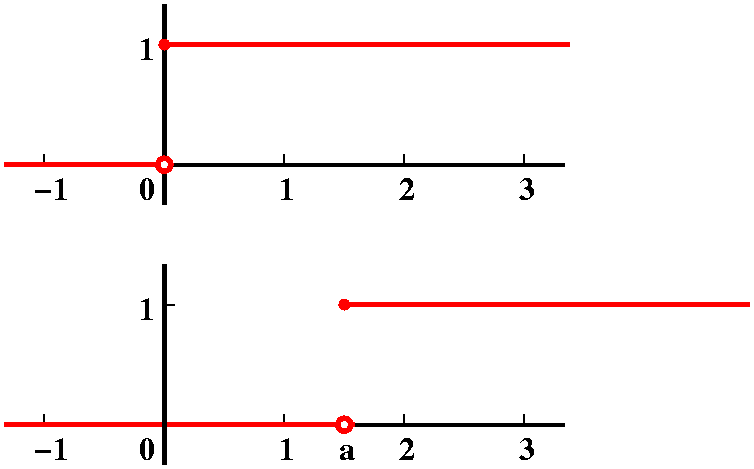 Naturally I want to begin with the second topic. The
Heaviside function is constant except for a jump of 1 at 0. It is the
simplest piecewise continuous function. Here
is a biography of Heaviside, whose life seems quite
interesting. So H(t) is 1 if t>=0 and 0 if t<0.
By the way, Heaviside is also what the Heaviside function is called both in
Maple and Matlab. What's the Laplace transform of H?
Notice, please, that the Laplace transform only "looks at"
t>=0. For such t, the Heaviside function is same thing as 1, and
1's Laplace transform is 1/s. So the Laplace transform of H is 1/s. If
a is a positive number, the function H(t-a) has a jump of 1 at a.
Let's compute the Laplace transform of H(t-a). So we start with
Naturally I want to begin with the second topic. The
Heaviside function is constant except for a jump of 1 at 0. It is the
simplest piecewise continuous function. Here
is a biography of Heaviside, whose life seems quite
interesting. So H(t) is 1 if t>=0 and 0 if t<0.
By the way, Heaviside is also what the Heaviside function is called both in
Maple and Matlab. What's the Laplace transform of H?
Notice, please, that the Laplace transform only "looks at"
t>=0. For such t, the Heaviside function is same thing as 1, and
1's Laplace transform is 1/s. So the Laplace transform of H is 1/s. If
a is a positive number, the function H(t-a) has a jump of 1 at a.
Let's compute the Laplace transform of H(t-a). So we start with
 0inftye-stH(t-a) dt and
this is 0inftye-stH(t-a) dt and
this is  ainftye-st dt: remember
to drop the part of the integral where H(t-a) is 0 and to keep (with
1) the other part of the integral. This integral is easy to
compute. We get -e-st/s|t=at=infty. The
infinity term disappears (exponential decrease) and the other part is
e-as/s. So if we translate the Heaviside function into the
future, the Laplace transform which is 1/s gets multiplied by a compensating
exponential, e-as. ainftye-st dt: remember
to drop the part of the integral where H(t-a) is 0 and to keep (with
1) the other part of the integral. This integral is easy to
compute. We get -e-st/s|t=at=infty. The
infinity term disappears (exponential decrease) and the other part is
e-as/s. So if we translate the Heaviside function into the
future, the Laplace transform which is 1/s gets multiplied by a compensating
exponential, e-as.
What happens to the future?
This is actually always true:
translation of the vibration/signal y(t) into the future by a (that
is, y(t-a)) will multiply the Laplace transform Y(s) by
e-as.
Example #1
Look at the bump we introduced in the first lecture:
"a square wave: a function given by f(x)=0
for x<3 and for x>7 and f(x)=5 for x in [3,7]". This can be
written using translates of the Heaviside function in a neat
way. First, we don't need anything before t=3. At t=3, we want a jump
of 5: 5H(t-3). Then we want to jump down at t=7: -5H(t-7). So this
square wave can be written, symbolically, as 5H(t-3)-5H(t-7). We can
compute the Laplace transform using linearity and the future idea
above gives 5e-3s/s-5e-7s/s. I thank
Mr. Obbayi for helping me with the
correct variables in the exponentials here and in the other examples.
I was told that this answer was the same as the answer we got by
direct computation in the first lecture.
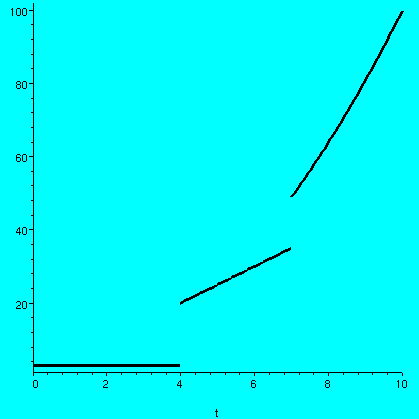 Example #2
Example #2
Here I tried a piecewise polynomial. The function f(t) was something
like this: f(t) was 3 for t<4, and was 5t for t in the interval
[4,7], and was t2 for t>7. How can we write this using
Heaviside functions? First f(t) is 3. Then we need to "switch on" 5t
at t=4, so we need H(t-4)5t. And we want to similarly switch on
t2 at t=7, so we need H(t-7)t2. But this so far
isn't exactly correct. We need to turn off the previous signal
when we introduce the new one. So this f(t) is actually
3+H(t-4)(5t-3)+H(t-7)(t2-5t). By the way, to the right is
the result of the Maple command:
plot(3+Heaviside(t-4)*(5*t-3)+Heaviside(t-7)*(t^2-5*t), t=0..10,
discont=true, color=black, thickness=3);
So you can see that Maple understands this language well.
Since f(t)=3+H(t-4)(5t-3)+H(t-7)(t2-5t), we can try to find
the Laplace transform of f(t). Linearity again helps. We need
to transform each piece. The Laplace transform of 3 is 3/s. What about
H(t-4)(5t-3)? If this were a function of t-4 then its transform would
be the transform of the function whose argument is t-4 then
multiplied by e-4s for the time shift. But, golly,
5t-3=5(t-4+4)-3=5(t-4)+17. Therefore H(t-4)(5t-3) is actually
H(t-4)(5(t-4)+17). This is a time shift of the function H(w)(5w+23),
whose Laplace transform is 5/s2+17/s (we had a small table
of Laplace transforms on the board). Now multiply by the appropriate
exponential factor, and the Laplace transform of H(t-4)(5t-3) is
"just" e-4s(5/s2+17/s). Now we need to handle
the last chunk, which is H(t-7)(t2-5t). Now I would like
to write t2-5t in terms of t-7. Do this with the following
somewhat tedious algebra:
t2-5t=(t-7 +7)2-5(t-7 +7).
Therefore we have
t2-5t=(t-7)2+14(t-4)+49-5(t-7)-35=(t-7)2+9(t-7)+14.
And so the Laplace transform of H(t-7)(t2-5t) will be the
Laplace transform of H(t-7)[(t-7)2+9(t-7)+14]. We look
things up and find out that w2+9w+14 has Laplace transform
2/s3+9/s2+14/s. Therefore (time shift) the
Laplace transform of H(t-7)[(t-7)2+9(t-7)+14] is
e-7s(2/s3+9/2+14/s.
Now we can put it all together and declare that the Laplace transform
of f(s) is
3/s+e-4s(5/s2+17/s)+e-7s(2/s3+9/2+14/s.
Wow!
Technology
I checked my computation with Maple. First I typed
with(inttrans): which loaded the Laplace transform package in
addition to other stuff. Then I typed
laplace(MY FUNCTION,t,s); and
Maple gave me the answer. In fact, it gave me the
correct answer, since earlier I had a sign error!
Here is an alternate way to write t2-5t as a function of
t-7: use Taylor series. I know that g(t) should equal
g(7)+g'(7)(t-7)+[g''(7)/2](t-7)2+... and when
g(t)=t2-5t I compute: g(7)=49-35=14 and g'(t)=2t-5 and
g'(7)=9 and g''(t)=2 and g''(7)=2. The higher order derivatives are
all 0. So g(t)=14+9(t-7)+[2/2](t-7)2. This is the same as
what we got before, but you may like this process more.

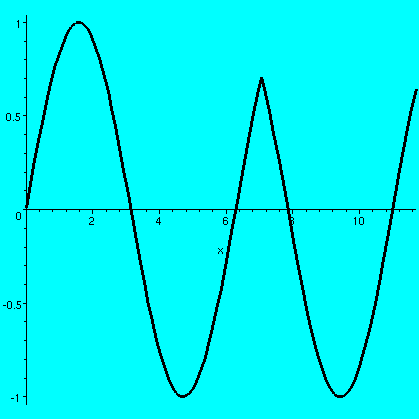 Example #3
Example #3
Please note that the pictures here are drawn by Maple in
unconstrained mode, filling up the boxes. They are distorted --
the vertical and horizontal axes have different units. The green
curve is cosine and the blue
curve is sine. I would like to create a piecewise function
by taking sine from 0 to its second positive intersection with cosine,
and then switching to cosine. This intersection is at 9Pi/4. So the
function f(s) is sin(s) for s in [0,9Pi/4] and is cos(s) for
s>Pi/4. A graph of it is on the right. First I will express this in
terms of Heaviside functions:
f(t)=sin(t)+H(t-9Pi/4)(cos(t)-sin(t)). But we want the time-shifted
part to be written in terms of t-9Pi/4. Perhaps I could use the Taylor
series here, as Mr. Ivanov
suggested. But here's another trick. Of course
cos(t)=cos((t-9Pi/4)+9Pi/4). Recall (??) that
cos(A+B)=cos(A)cos(B)-sin(A)sin(B) so that
cos(t)=cos((t-9Pi/4)+9Pi/4)=cos(t-9Pi/4)cos(9Pi/4)-sin(t-9Pi/4)sin(9Pi/4)=(1/sqrt(2)[cos(t-9Pi/4)-sin(t-9Pi/4)]
because both sine and cosine at 9Pi/4 are 1/sqrt(2).
Therefore H(t-9Pi/4)[cos(t)] is
H(t-9Pi/4)[(1/sqrt(2)[cos(t-9Pi/4)-sin(t-9Pi/4)], and, since our
Laplace transform table
contains both sine and cosine, the Laplace transform must be
e-(9Pi/4)s(1/sqrt(2))[s/(s2+1) +
1/(s2+1)]. This is also what Maple got, so I am
happy!
The sine part can be dealt with similarly, provided you know a formula
for sin(A+B). If you want to do this yourself and check your answer,
Maple tells me that the Laplace transform of all of f(s)
(once it is simplified) is
[1-e-(9Pi/4)tsqrt(2)]/[s2+1].
I rather daringly attempted problem #42 in section 3.3: an even
problem with a large number! Here is the heart of the problem: we want
to solve y'-3y=g(t) with the initial condition y(0)=2 and with g(t)=0
for t in [0,4] and g(t)=3 for t>4. Well, g(3) is 3H(t-4) so we need
to solve y'-3y=3H(t-4) with y(0)=2. Take the Laplace transform of both
sides. We get: sY(s)-y(0)-3Y(s)=e-4s/s. Here Y(s) is the
Laplace transform of the unknown function y(s). Then y(0)=2 so we can
"solve" for Y(s). It is Y(s)=e-4s/[s(s-3)]+2/(s-3). We
split up 1/[s(s-3)] so it becomes [-1/s]+[1/(s-3)], all divided by
3. Therefore
Y(s)=(1/3)e-4s([-1/s]+[1/(s-3)])+2/(s-3). Apply Lerch's
Theorem, which means we try to do an inverse Laplace transform (look
at the Laplace transform tables backwards!). 2/(s-3) comes from
2e3t and the other part is the inverse Laplace transform of
(1/3)(-1+e3t) time-shifted by 4, and this is
H(t-4)(1/3)(-1+e3(t-4)). Thus y(t) is the sum
H(t-4)(1/3)(-1+e3(t-4))+2e3t. We might write
this is a more traditional form: if t is between 0 and 4,
y(t)=2e3t, and for t>4,
y(t)=(1/3)e3t-12-1/3+2e3t.
Comments on the solution
Well, for t between 0 and 4, 2e3t does solve y'-3y=0 with
y(0)=2. That's easy to check. And for t>3,
y(t)=(1/3)e3t-12-1/3+2e3t=[2+(1/3)e-12]e3t-1/3,
and -1/3 solves y'-3y=3 and the other part is a solution of the
homogeneous equation. The Laplace transform is also marvelous in that
it selects the two pieces so that together they form a continuous
curve. That is, the limit of y(t) from either the left or the right at
t=4 is 2e12, the same number. This is really neat!
The QotD was to compute the inverse Laplace transform of
e-5s(3/s-7/(s-1)+3/[s2+1]. This is a time-shift
by 3 of a simple sum of things whose Laplace transforms we know. So it
must be 3H(t-5)-7et-5H(t-5)+cos(t-5)H(t-5). Alternatively,
this function is 0 for t less than 5, and for t>5, it is
3+et-5+cos(t-5).
Read the book and do homework problems!
|
Thursday,
January 22 |
I wrote the definition of Laplace transform again, and the several
transforms we had computed during the first class. I wanted to show
students several neat computations of Laplace transforms. Here I
used the word "neat" in a less common sense which my on-line
dictionary gives as "cleverly executed".
Neat computation #1: sine and cosine
I would like to compute the Laplace transform of sin(t). So the
definition tells me that I need to compute
 0inftye-stsin(t) dt:
o.k. this really isn't too difficult: I would integrate by parts,
etc. But I would also like the Laplace transform of cos(t). Here is
another way to get them. I remember this formula of
euler: eit=cos(t)+i sin(t). I will compute the Laplace
transform of eit which is easy: 0inftye-stsin(t) dt:
o.k. this really isn't too difficult: I would integrate by parts,
etc. But I would also like the Laplace transform of cos(t). Here is
another way to get them. I remember this formula of
euler: eit=cos(t)+i sin(t). I will compute the Laplace
transform of eit which is easy:
 0inftye-steitdt= 0inftye-steitdt= 0inftye(-s+i)tdt=[1/(-s+i)]e-(s-i)t|t=0t=infty.
The term with t=infty is 0 because e-st-->0. The other term
gives -1/(-s+i). The - sign comes because t=0 is a lower bound. 0inftye(-s+i)tdt=[1/(-s+i)]e-(s-i)t|t=0t=infty.
The term with t=infty is 0 because e-st-->0. The other term
gives -1/(-s+i). The - sign comes because t=0 is a lower bound.
Now we work with -1/(-s+i): multiply top and bottom by (-s-i). The result
is -(-s-i)/(s2+1)=[s/(s2+1)]the real
part+i[1/(s2+1)]the imaginary part. But Laplace
transform is linear, so
L(eit)=L(cos(t)+i sin(t))=(cos(t))the
real part)+iL(sin(t))the imaginary part. Therefore the
Laplace transform of cosine is s/(s2+1) and the Laplace
transform of sine is 1/(s2+1).
Neat computation #2: lots of bumps
Let's find the Laplace transform of a square wave again. This will be
a wave of height 1 from 1 to 2. I will call this SW[1,2]. What is
its Laplace transform?  0inftye-stSW[1,2]dt= 0inftye-stSW[1,2]dt= 12e-stdt=(-1/s)e-st|t=1t=2=(-1/s)(e-2s-e-s).
There are a number of comments to make here. First, the (nominally)
improper integral defining the Laplace transform has become a "proper"
integral, and rather an easy one. Second, the Laplace transform
actually has only an apparent singularity at s=0. This is because the
limit as s-->0 is actually 1 (use L'Hopital, or look at the first
terms of the Taylor series of the exponentials). 12e-stdt=(-1/s)e-st|t=1t=2=(-1/s)(e-2s-e-s).
There are a number of comments to make here. First, the (nominally)
improper integral defining the Laplace transform has become a "proper"
integral, and rather an easy one. Second, the Laplace transform
actually has only an apparent singularity at s=0. This is because the
limit as s-->0 is actually 1 (use L'Hopital, or look at the first
terms of the Taylor series of the exponentials).
The Laplace transform of SW[1,2] is
(-1/s)(e-2s-e-s).
| Graph of SW[1,2] | |
Graph of its Laplace
transform |
|---|
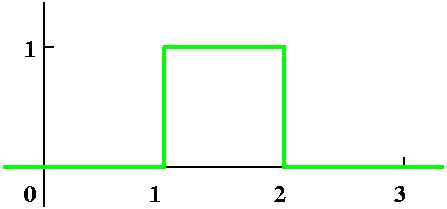 |
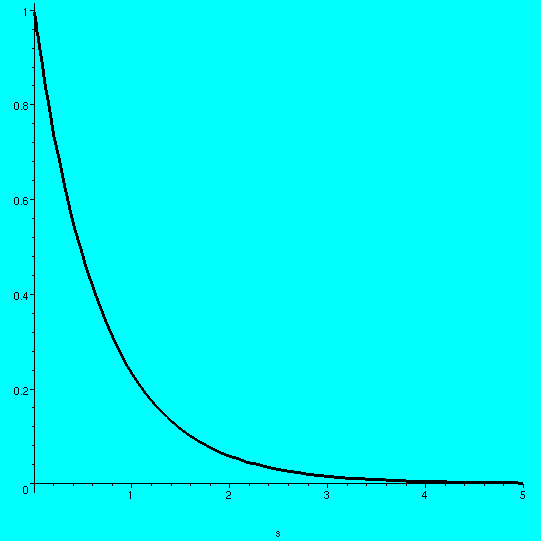 |
Let's find the Laplace transform of a square wave again. This will be
a wave of height 1 from 3 to 4. I will call this SW[3,4]. What is
its Laplace transform?  0inftye-stSW[3,4]dt= 0inftye-stSW[3,4]dt= 34e-stdt=(-1/s)e-st|t=3t=4=(-1/s)(e-4s-e-3s). 34e-stdt=(-1/s)e-st|t=3t=4=(-1/s)(e-4s-e-3s).
The Laplace transform of SW[3,4] is
(-1/s)(e-4s-e-3s).
I bet that the Laplace transform of SW[5,6] is
(-1/s)(e-6s-e-5s).
ETC. By that I mean that we could add up an
infinite train of square waves, progressing at integer intervals along
the horizontal axis, and have a Laplace transform which is the sum of
(-1/s)(e-2s-e-s)+
(-1/s)(e-4s-e-3s)+
(-1/s)(e-6s-e-5s)+
...
Now the exponentials in each vertical column are geometric series. Here
please recall that
a+ar+ar2+ar3+...=[a/(1-r)]. The series in the
first vertical column is
e-2s+e-4s+e-6s+... which is a
geometric series whose first term is a=e-2s and whose ratio
is r=e-2s. Its sum is e-2s/(1-e-2s).
The series in the second vertical column is
e-s+e-3s+e-5s+... and now
a=e-s and r is again e-2s, so its sum is
e-s/(1-e-2s). Now package it all together,
keeping track of -'s correctly.
The Laplace transform is
(-1/s)[(e-2s-e-s)/(1-e-2s)]. O.k.,
this is not pretty, but it is a real achievement. In all of our
calc 1-2-3 courses, and even in 244, we generally looked only at
functions defined by nice formulas and gotten tools for them. Here we
converted a really horrible function (from that traditional calc
point of view), an infinite train of square waves, into a formula. If
we can do interesting things with the formula on the Laplace transform
side, then we'll be able to really work with the square waves.
| Graph of the square wave train |
|---|
 |
A kind biomedical student pointed out after class
that what I created was actually a rather rudimentary model of blood
flow driven by a heart beat, so maybe this isn't that silly.
Now let's move on to differential equations, and see how Laplace
transform would handle some ODE's we can already solve. First we need
to get a formula for the Laplace transform of a derivative.
I want
 0inftye-stf'(t) dt to be
written in terms of the Laplace transform of f. Since we don't know
very much and we have a product of two weird (well, no, let me just
write two not obviously related) functions, we could try integration
by parts. The suggestion was made that we use u=e-st and
dv=f'(t) dt. Then du=(-s)e-stdt and v=f(t). The uv
term becomes e-stf(t)t=0t=infty. The
"infty" goes away because of exponential decay, and the t=0 gives
-f(0). The other term is - 0inftye-stf'(t) dt to be
written in terms of the Laplace transform of f. Since we don't know
very much and we have a product of two weird (well, no, let me just
write two not obviously related) functions, we could try integration
by parts. The suggestion was made that we use u=e-st and
dv=f'(t) dt. Then du=(-s)e-stdt and v=f(t). The uv
term becomes e-stf(t)t=0t=infty. The
"infty" goes away because of exponential decay, and the t=0 gives
-f(0). The other term is - 0infty(-s)e-stf(t). The -
sign in front of the integral comes from -integral of v du. The
-s is a constant for dt integration, so it comes out. What we have
then is L(f')=sL(f)-f(0). The traditional Laplace
transform notation seems to be to use capital letters to correspond to
small letters of the original function, so the Laplace transform of f
is called F. Then written traditionally we have the rule
L(f')=sF-f(0). This is Theorem 3.5 in section 3.2 of the
text. Another integration by parts gets us
L(f'')=s2-sf(0)-f'(0). There are further formulas
for higher derivatives. 0infty(-s)e-stf(t). The -
sign in front of the integral comes from -integral of v du. The
-s is a constant for dt integration, so it comes out. What we have
then is L(f')=sL(f)-f(0). The traditional Laplace
transform notation seems to be to use capital letters to correspond to
small letters of the original function, so the Laplace transform of f
is called F. Then written traditionally we have the rule
L(f')=sF-f(0). This is Theorem 3.5 in section 3.2 of the
text. Another integration by parts gets us
L(f'')=s2-sf(0)-f'(0). There are further formulas
for higher derivatives.
Solving problems again we can already solve
Everyone who took 244 or a similar course should be able to solve
these problems. But here we will try to use the Laplace transform to
solve these problems.
Math 244-style problem #1
Solve y''+y=et with initial conditions y(0)=0 and y'(0)=0.
Here the homogeneous solutions are sine and cosine, and the particular
solution will be some sort of et multiple. So the result we
get shouldn't look too unexpected. Take the Laplace transform of both
sides of the equation. The right-hand side, et, has Laplace
transform 1/(s-1). I could get this by computation but I would rather
look it up (or have Maple etc. compute it). The Laplace
transform of the left-hand side is s2Y(s)-sY(0)-Y(0)+Y(s),
where Y(s) is the Laplace transform of y(t). The initial conditions
immediately imply that the left-had side's transform is just
(s2+1)Y(s). Therefore we know that
Y(s)=1/[(s2+1)(s-1)]. Now I have been told that it is just
"high school algebra" from here. The idea is to decompose the
fraction into pieces and recognize each of the pieces as the Laplace
transform of a known function. A result quoted in the textbook
(Lerch's Theorem is Theorem 3.3 in section 3.1 -- I always liked the name
Lerch
but only just found out who he was) says that you can reverse the
columns of a Laplace transform table, and just "look up" the original
function. So I need to decompose 1/[(s2+1)(s-1)] into a sum
of terms which I recognize as Laplace transforms, and then use the
linearity of Laplace transform and the table of known Laplace
transforms. The technique of partial fractions says that
1/[(s2+1)(s-1)] can be written as
(As+B)/(s2+1)+C/(s-1). We combine the fractions and look
only at the top of each side: 1=(As+B)(s-1)+C(s2+1). When
s=1, we get C=1/2. Comparing s2 coefficients we get
A=-1/2. Comparing the constant terms on both sides we get B=-1/2. So
Y(s)=(-1/2)(s/(s2+1)+(-1/2)(1/(s2+1)+(1/2)(1/(s-1)).
These pieces are all known Laplace transforms, so we can read off
y(t): it is (-1/2)cos(t)+(-1/2)sin(t)+(1/2)et. If you are
suspicious, you can check this satisfies the ODE and its initial
conditions. (I did.)
Math 244-style problem #2
I dared to try an even-numbered problem in the text (but not too
high an even number, only 3.2 #2): y'-9y=t with y(0)=5.
The Laplace transform of both sides gives sY(s)-y(0)=1/s2.
If we use the initial condition we get sY(s)-5=1/s2. Solve
for Y(s) to get Y(s)=1/[s2(s-9)]+5/(s-9). If I sneak a look
into the textbook's table of Laplace transforms, I see that the
Laplace transform of eat is 1/(s-a). So 5/(s-9) is the
Laplace transform of 5e9t. We still must decompose
the other term. But (partial fractions again) this is a sum of
[A/(s-9)]+[B/s]+[C/s2] and this is
As2+Bs(s-9)+C(s-9) (divided by stuff I'll ignore) which
should be equal to 1 (divided by the same stuff). If s=9 we get 81A=1
so A=1/81. If s=0, we get -9C=1 so C=-1/9. Comparing s2
coefficients gives B=-1/81. Therefore
Y(s)=(1/81)[1/(s-9)]+(-1/81)[1/s]+(-1/9)[1/s2]+5/(s-9). Now
we use Lerch's Theorem and the table of Laplace transforms to read off
the solution:
y(t)=(1`/81)e9t+(-1/81)(1)+(-1/9)t+5e9t.
I used Maple to check that this actually worked, because I
was exhaust by the end of the computation.
Technology note
Both Maple and Matlab have packages with Laplace and
inverse Laplace transforms. I have tried using them, and they sort of
work. In Maple you must load the package inttrans
and in Matlab you must have the symbolic toolbox.
The QotD was to compute the Laplace transform of the up and
down bump SW[1,2]-SW[2,3]. I think and hope this
was easy.
 Please read 3.1 and 3.2 of the
text. If you wish to prepare a bit for next week, look at 3.3 and
3.4. Please hand in 3.1: 8,13 and 3.2:9,10 and also compute the
Laplace transform of a "tent": a piecewise linear function which is 0
except between A and A+2 (here A is an unspecified positive
number). In the interval [A,A+2] the function's graph is a line
segment from (A,0) to
(A+1,1) and is a line segment from (A+1,1) to (A+2,0).
A picture is shown to the right.
Please read 3.1 and 3.2 of the
text. If you wish to prepare a bit for next week, look at 3.3 and
3.4. Please hand in 3.1: 8,13 and 3.2:9,10 and also compute the
Laplace transform of a "tent": a piecewise linear function which is 0
except between A and A+2 (here A is an unspecified positive
number). In the interval [A,A+2] the function's graph is a line
segment from (A,0) to
(A+1,1) and is a line segment from (A+1,1) to (A+2,0).
A picture is shown to the right.
|
Tuesday,
January 20 |
Some discussion of the history of the course and its present condition. I mentioned that
the material of this course was also of interest to electrical
engineers, and if I use the word "signal" it should be heard by
students of Mechanical Engineering as "vibration".
How to solve y''+5y'+y=0. Realize this is a linear second order
homogeneous ordinary differential equation. Please: students should
have had a differential equations course, and should be able to
understand the exact meaning of every word of the phrase linear second order homogeneous ordinary
differential equation. Ordinary differential equation
will be abbreviated "ODE".
In this "linear" is the
most important word:
- If y1 and y2 are
solutions, then y1+y2 is a solution.
- If a is a constant (either real or complex, depending on our
mood), and y is a solution, then a y is also a solution.
Can differential equations be "solved"? For example,
y'=sin(x17)? iF "solved" means "find an explicit formula in
terms of well-known functions" then, certainly, this differential
equation can't be solved. In fact, most differential equations can't
be solved. What then? Well, there are:
- Numerical methods to approximate solutions
- Qualitative methods (such as phase plane analysis) to learn about
limiting behavior or periodicity, etc.
But sometimes we are lucky, and we have good model situations. This is
one of them. For y''+5y'+y=0 we guess that a solution will be
of the form erx and if this is a solution, we have
erx(r2+5r+6)=0 and since exponentials are never
0 we should solve the equations r2+5r+6=0, the
characteristic equation. So we have (r+3)(r+2)=0 and
e-3x and e-2x are solutions. Therefore (again
using linearity) Ae-3x+Be-2x is a
solution.
The A and B can be used to specify a unique solution. The simplest
example is the initial value problem: y(0) and y'(0) are
specified. Then y(0)=A+B and y'(0)=-3A-2B (differentiate and set
x=0). any initial conditions can be matched by finding suitable
A and B. You should see that this is a consequence of a certain 2-by-2
matrix being invertible. The matrix is 1 1
-3 -2
We can also try to solve more complicated boundary value
problems such as: y(0) and y'(1) are specified , and then can we
get A and B to match up? Well, y(0)=A+B again and
y'(1)=-3e-3A-2e-2B. Then again, since 1 1
-3e-3 -2e-2
is invertible we can always solve this boundary value problem (a
vibrating "beam" with position at 0 and velocity at 1
specified). Please note that boundary value problems are generally
more delicate than initial value problems, and sometimes there are no
solutions (this will be discussed later in the course).
I asked how to solve y''+5y'+y=5ex, an inhomogeneous
equation. We again guess a solution (no, not
x33). We try ex and "feed it into"
y''+5y+6y and get 12ex and therefore a particular
solution will be (5/12)ex: again we took advantage of
linearity. General solutions are gotten by adding the particular
solution to solutions of the homogeneous equation.
So we will try to get methods to solve certain linear ODE's. The
functions we are interested in are exponentials and sine and cosine
and polynomials.
But sine and cosine are exponentials also, since
eix=cos(x)+i sin(x). As for x, it is the limit of
(erx-1)/r as r-->0 so x is almost an exponential (you
can check this assertion with l'Hopital's rule, as we did).
So we need sums of exponentials, indeed, linear combinations of
exponentials. Well, linear combinations with many terms are almost
integrals, so we should look at weighted sums of integrals of
exponentials.
The Laplace transform
We define this by Lf(s)= 0inftyf(t)e-stdt.
Of course L is supposed to be a script L. This will eventually
allow us to solve and analyze certain differential equations better. 0inftyf(t)e-stdt.
Of course L is supposed to be a script L. This will eventually
allow us to solve and analyze certain differential equations better.
We reviewed a bit about improper integrals. I remarked that it is hard
to tell by "looking" that as x-->infty, the area "under" 1/x does
not have a limit (since ln(R)-->infty as R-->infty) but
that the area "under" 1/x2 does have a limit (since
-1/x-->0 as R-->infty).Things must be carefully computed. Generally
functions that decay exponentially will have improper integrals
with finite values. I was interested most in the asymptotic
behavior of functions in order to analyze {con|di}vergence of improper
integrals.
We found that the Laplace transform of the function 1 was 1/s: t is
the "time" variable and is used in the integrand. I just directly
computed the integral.
We found that the Laplace transform of the function t was
1/s2. Here I needed to integrate by parts. The
choice of sign in the definition of Laplace transform allows some
amazing coincidences to occur (they are not coincidences --
these have been planned to make computation work more easily).
Since exponential decay will always "overpower" polynomial growth (of
any degree) any polynomial will have a Laplace transform. Also so will
sine and cosine and lots of other things. Although this is nice, what
is more interesting is that the Laplace transform will allow us to
compute with rough: functions very nicely, functions that
commonly arise in real world problems. So I computed that
Laplace transform of a square wave: a function given by f(x)=0
for x<3 and for x>7 and f(x)=5 for x in [3,7]. This was
easy!
The Laplace transform is linear:
- L(y1+y2)=L(y1)+L(y2)
- L(ay)=aL(y)
because integral is linear.
The Question of the Day (QotD) was: tell me the Laplace
transform of 3+2t.
Answer I expected that students would use linearity and would
use the previously computed Laplace transforms to give the answer
(3/s)+(2/s2).
I will do more example of Laplace transforms next time and show how
they can be used to solve some ODE's.
Please start reading chapter 3, and begin doing
the textbook problems. Hand in the entrance exam on
Thursday.
To succeed in this course you will need techniques from calc 2 (such
as integration by parts,
partial fractions, power series, and improper integrals) and
background in basic
linear algebra. I'd like some confirmation that you can do what
you should be able to, and maybe this confirmation (or other
information!) will also help you.
|
 For many students, Problem #15 of section 3.5 was the first
boundary value problem they had seen. ODE's usually have many
solutions. Picking out solutions with initial values is
simplest: "Superman leaps from a 20 story tall building with a
velocity of 20,000 furlongs per fortnight ..." But that's not the way
natural problems are always stated. Superman may leap from a building,
but he might want to be a specifc place at some specific later time.
For many students, Problem #15 of section 3.5 was the first
boundary value problem they had seen. ODE's usually have many
solutions. Picking out solutions with initial values is
simplest: "Superman leaps from a 20 story tall building with a
velocity of 20,000 furlongs per fortnight ..." But that's not the way
natural problems are always stated. Superman may leap from a building,
but he might want to be a specifc place at some specific later time.
 I asked how H, the Heaviside function, and delta, the Dirac
delta function, were related. In the operational calculus we have been
studying, it turns out that H' should be delta. So if we have a
change in something which jumps, the derivative of this change should
be delta (this is relevant to the salt problem I discussed last
time).
I asked how H, the Heaviside function, and delta, the Dirac
delta function, were related. In the operational calculus we have been
studying, it turns out that H' should be delta. So if we have a
change in something which jumps, the derivative of this change should
be delta (this is relevant to the salt problem I discussed last
time).




 I then asked students to think about the physical motion of such a
spring which is kicked every Pi, so that y''+y=the sum of
delta(t-j Pi) as j goes from 1 to infinity. I asked people
to guess what the physical motion of the spring would be. After some
silence, Mr. Morgan waved a finger to
illustrate the beginning of a graph which looked like what's
displayed. I said that was correct, and solution of the model shows
exactly such behavior. There didn't seem to be much agreement, so I
remarked that I would make this
I then asked students to think about the physical motion of such a
spring which is kicked every Pi, so that y''+y=the sum of
delta(t-j Pi) as j goes from 1 to infinity. I asked people
to guess what the physical motion of the spring would be. After some
silence, Mr. Morgan waved a finger to
illustrate the beginning of a graph which looked like what's
displayed. I said that was correct, and solution of the model shows
exactly such behavior. There didn't seem to be much agreement, so I
remarked that I would make this 

 Something a bit startling has occurred. When I began discussing Laplace
transforms, I declared that if f(t) were some sort of blobby function,
then the Laplace transform would be gotten by integrating the product
of f(t) with e-st. And if you consider the picture, when s
gets really really really large, then the exponential dies down very
very very fast, and so the Laplace transform should -->0 as
s-->infty. But we seem now to have a Laplace transform (the limit of
the square waves) which is is 1, so something seems wrong. This is
more or less the position of academic mathematicians when Heaviside
was presenting his methods. In fact, almost half a century passed
before the ideas of Heaviside would become part of rigorous
mathematical thought. His feeling, and that of many engineers and
physicists, was that, my goodness, the methods work, so use them and
don't worry too much.
Something a bit startling has occurred. When I began discussing Laplace
transforms, I declared that if f(t) were some sort of blobby function,
then the Laplace transform would be gotten by integrating the product
of f(t) with e-st. And if you consider the picture, when s
gets really really really large, then the exponential dies down very
very very fast, and so the Laplace transform should -->0 as
s-->infty. But we seem now to have a Laplace transform (the limit of
the square waves) which is is 1, so something seems wrong. This is
more or less the position of academic mathematicians when Heaviside
was presenting his methods. In fact, almost half a century passed
before the ideas of Heaviside would become part of rigorous
mathematical thought. His feeling, and that of many engineers and
physicists, was that, my goodness, the methods work, so use them and
don't worry too much.
 So it is time to solve a differential equation. Let's try something
simple (of course!): y''+y=delta(t-2) with the initial
condition y(0)=0 and y'(0)=0. So this is a vibrating spring with no
damping initially unmoving and in equilibrium, which we kick at
t=2. Let's take the Laplace transform. The left-hand side is easy
because all the complicated stuff drops out due to the initial
conditions. We get (s2+1)Y(s). The right-hand side is
e-2s1 (the "1" is the Laplace transform of the delta
function and the e-2s is because we have shifted by 2 in
the time variable). Then Y(s)=(e-2s)/(s2+1). We
transform back, noting that the exponential now makes "everything"
start at 2: y(t)=H(t-2)sin(t-2). Here is the entire dialog of a
Maple session to compute the solution, and then produce the
graph shown.
So it is time to solve a differential equation. Let's try something
simple (of course!): y''+y=delta(t-2) with the initial
condition y(0)=0 and y'(0)=0. So this is a vibrating spring with no
damping initially unmoving and in equilibrium, which we kick at
t=2. Let's take the Laplace transform. The left-hand side is easy
because all the complicated stuff drops out due to the initial
conditions. We get (s2+1)Y(s). The right-hand side is
e-2s1 (the "1" is the Laplace transform of the delta
function and the e-2s is because we have shifted by 2 in
the time variable). Then Y(s)=(e-2s)/(s2+1). We
transform back, noting that the exponential now makes "everything"
start at 2: y(t)=H(t-2)sin(t-2). Here is the entire dialog of a
Maple session to compute the solution, and then produce the
graph shown.


 #4
#4 Again, graphical input: the function was composed of three pieces of
straight lines. It was 0 until 5, then a line segment from (5,0) to
(6,1), and then a horizontal "ray" at height 1. We can write this
function as H(t-5)(line from (5,0) to (6,1))+H(t-6)(1-[line from (5,0)
to (6,1)]). The line connecting (5,0) to (6,1) has slope 1 and goes
through (5,0), so that its formula must be t-5. The function whose
Laplace transform we want is therefore
H(t-5)(t-5)+H(t-6)(1-[t-5])=H(t-5)(t-5)+H(t-6)(-t+6). Since (-t+6) is
-(t-6) we can apply the shifting theorem "immediately"(well,
almost). The desired Laplace transform is
e-5s(1/s2)-e-6s(1/s2).
Again, graphical input: the function was composed of three pieces of
straight lines. It was 0 until 5, then a line segment from (5,0) to
(6,1), and then a horizontal "ray" at height 1. We can write this
function as H(t-5)(line from (5,0) to (6,1))+H(t-6)(1-[line from (5,0)
to (6,1)]). The line connecting (5,0) to (6,1) has slope 1 and goes
through (5,0), so that its formula must be t-5. The function whose
Laplace transform we want is therefore
H(t-5)(t-5)+H(t-6)(1-[t-5])=H(t-5)(t-5)+H(t-6)(-t+6). Since (-t+6) is
-(t-6) we can apply the shifting theorem "immediately"(well,
almost). The desired Laplace transform is
e-5s(1/s2)-e-6s(1/s2).
 Naturally I want to begin with the second topic. The
Heaviside function is constant except for a jump of 1 at 0. It is the
simplest piecewise continuous function.
Naturally I want to begin with the second topic. The
Heaviside function is constant except for a jump of 1 at 0. It is the
simplest piecewise continuous function.  Example #2
Example #2
 Example #3
Example #3


